Recently on my way through Chicago, I visited the Frank Lloyd Wright Home and Studio. I also drove by several other of his creations, but only toured his own home. In fact, there’s a whole Frank Lloyd Wright trail through Illinois you can follow.
I knew I liked Frank Lloyd Wright’s designs overall – the strong graphic lines and natural themes, the workman-like sturdy construction – but touring his home and feeling what it feels like really cemented my love. Inside his spaces can feel cozy and open at the same time. I love all the little nooks, crannies, and spaces-within-spaces. No open floor plans here! And even after over 100 years, it still somehow feels modern.
Frank Lloyd Wright Home and Studio
Situated in the beautiful Oak Park neighborhood of Chicago, architect Frank Lloyd Wright had his own home as well as his studio space where he and his team would draft plans and meet clients. Inside his home, you can see how he evolved it from a standard square house into something far more interesting over time.
Home Side
The tour starts at the front door of the family’s home, so I’ll start there too. It doesn’t look super Frank Lloyd Wright-y from that angle, and indeed, this house was built in 1889 in a pretty standard, foursquare-style. Meaning, two floors, four rooms on each floor. Over the years until they moved out in 1909, Frank Lloyd Wright used the house to workshop his architectural ideas before adding them into his designs. So a tour through the house is like a tour through time – starting with more conventional spaces and into the fantastical.
First, you come into a foyer and parlor/living room space. The ceilings are low but the windows are large with deep window seats. Decorative elements around lights and around the upper walls are almost Greek in design (and reflect the influence of Wright’s early employer, Louis Sullivan.)
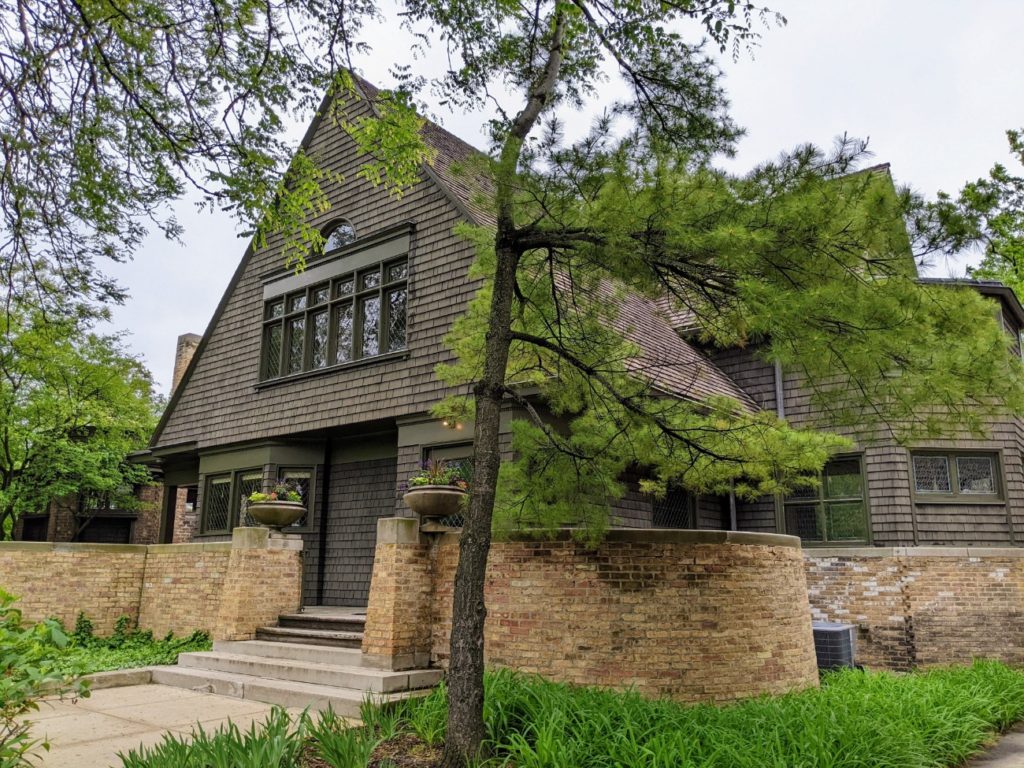
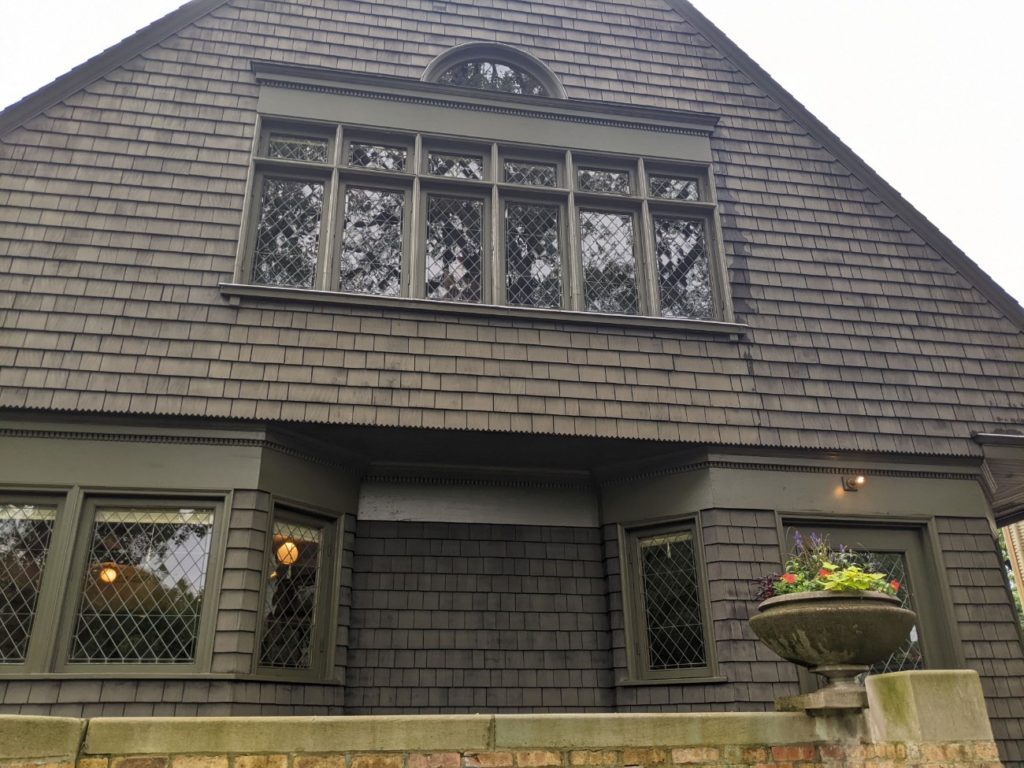
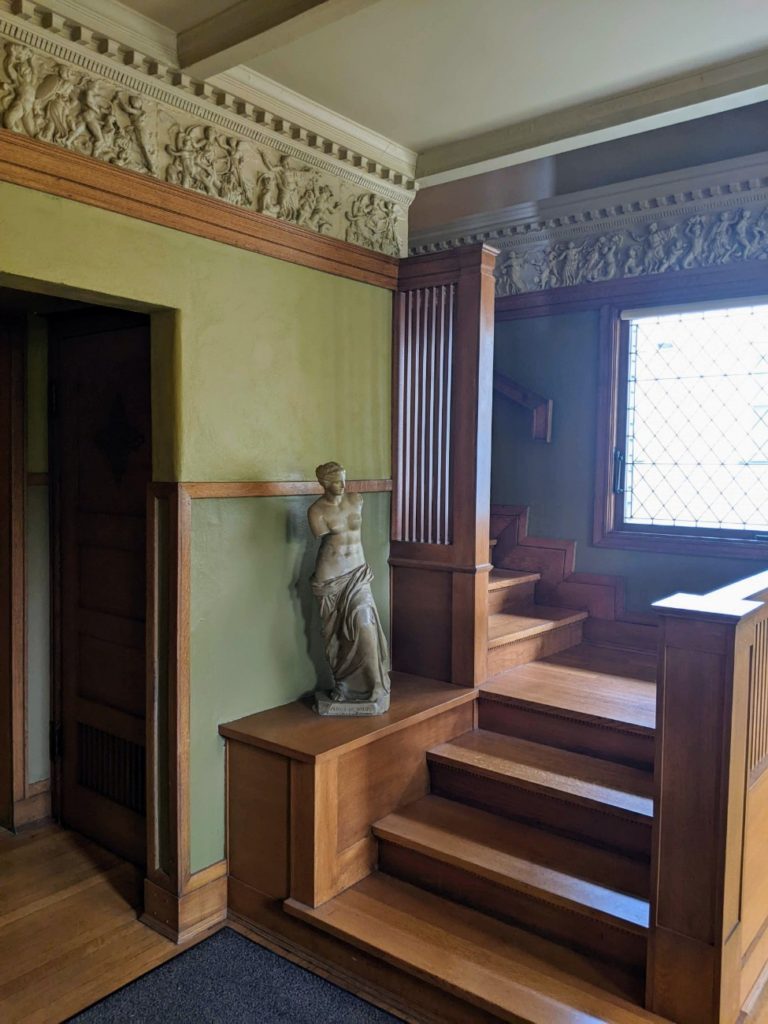
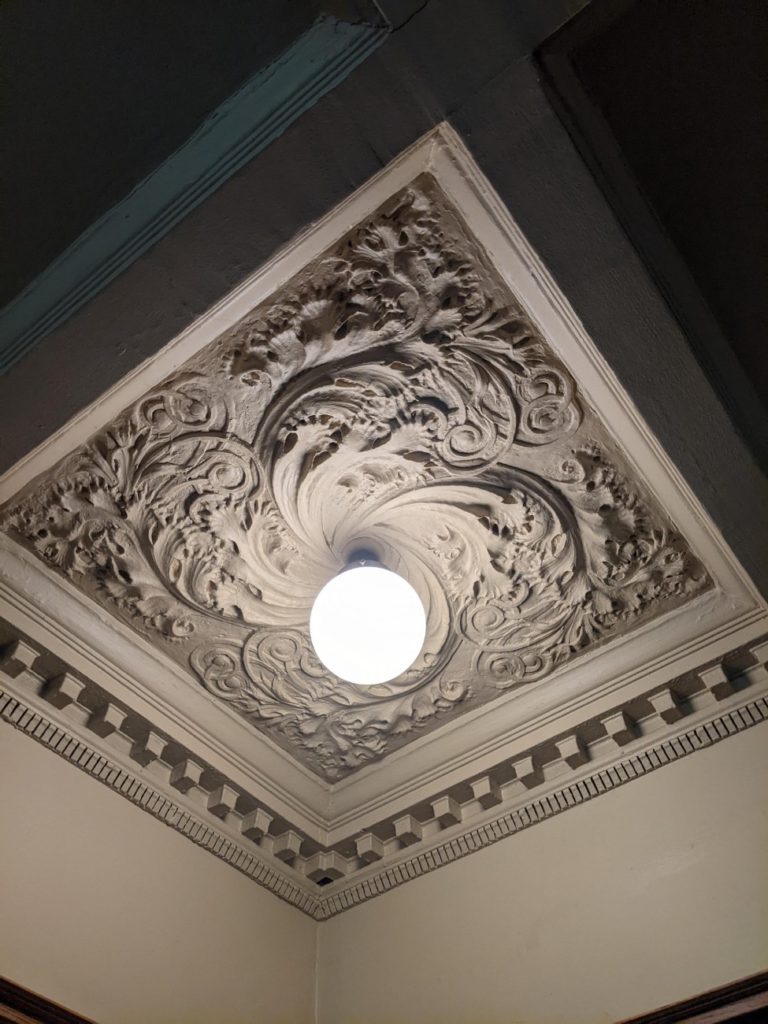
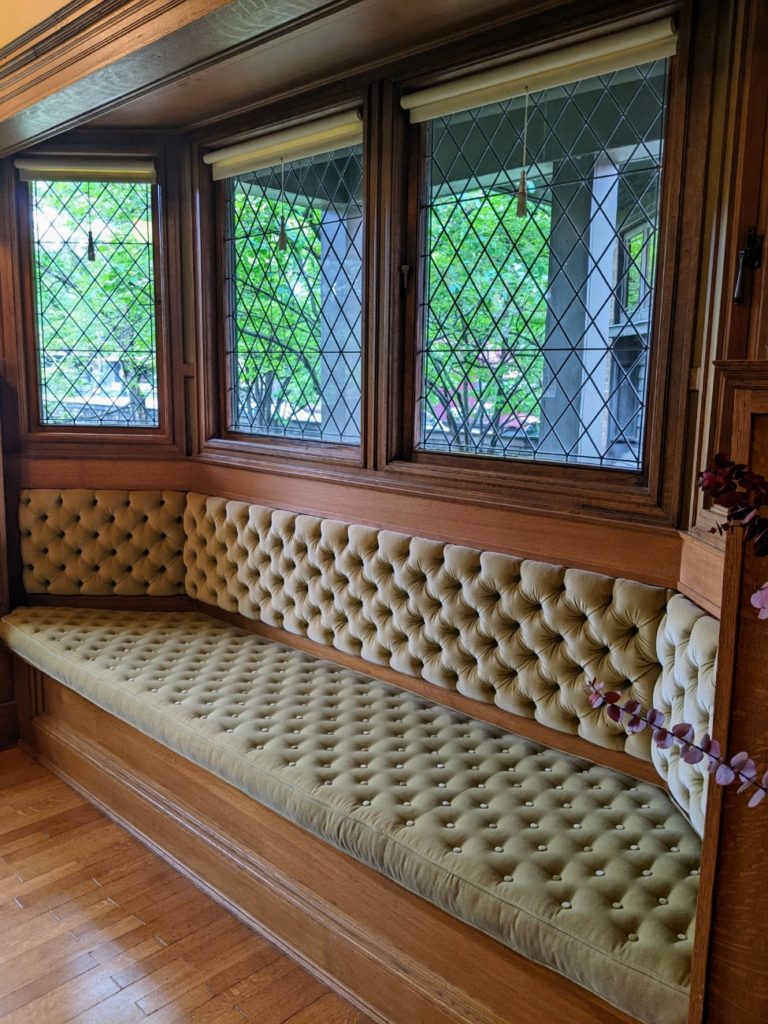
A lovely little nook in the front room has two more built-in seats flanking a brick fireplace. And true to Frank Lloyd Wright design, lots of hidden storage. Both the fireplace nook and the front room have heavy green curtains that can be pulled shut for more privacy. Which was probably helpful since Frank and his first wife Kitty had six kids in this house.
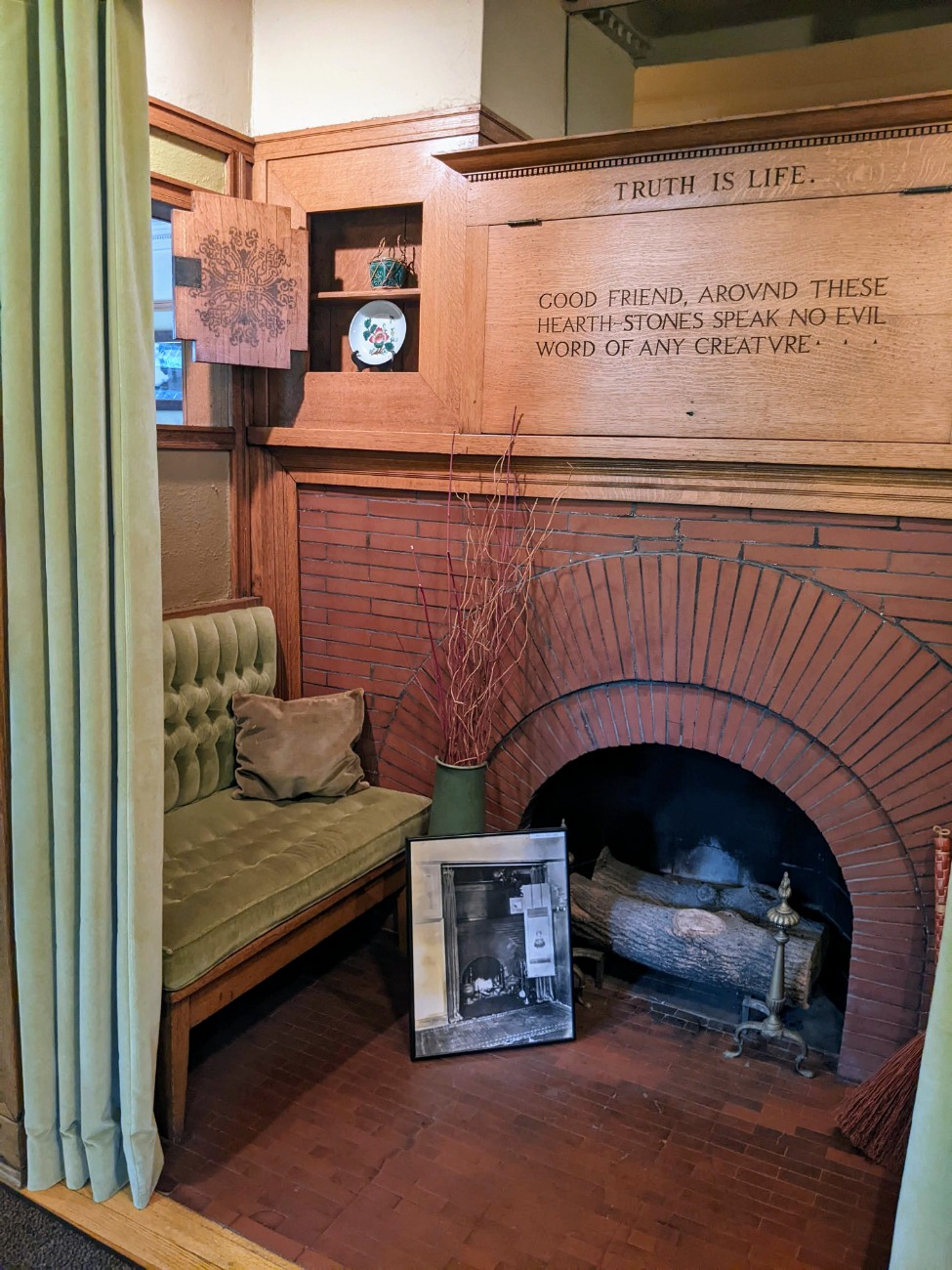
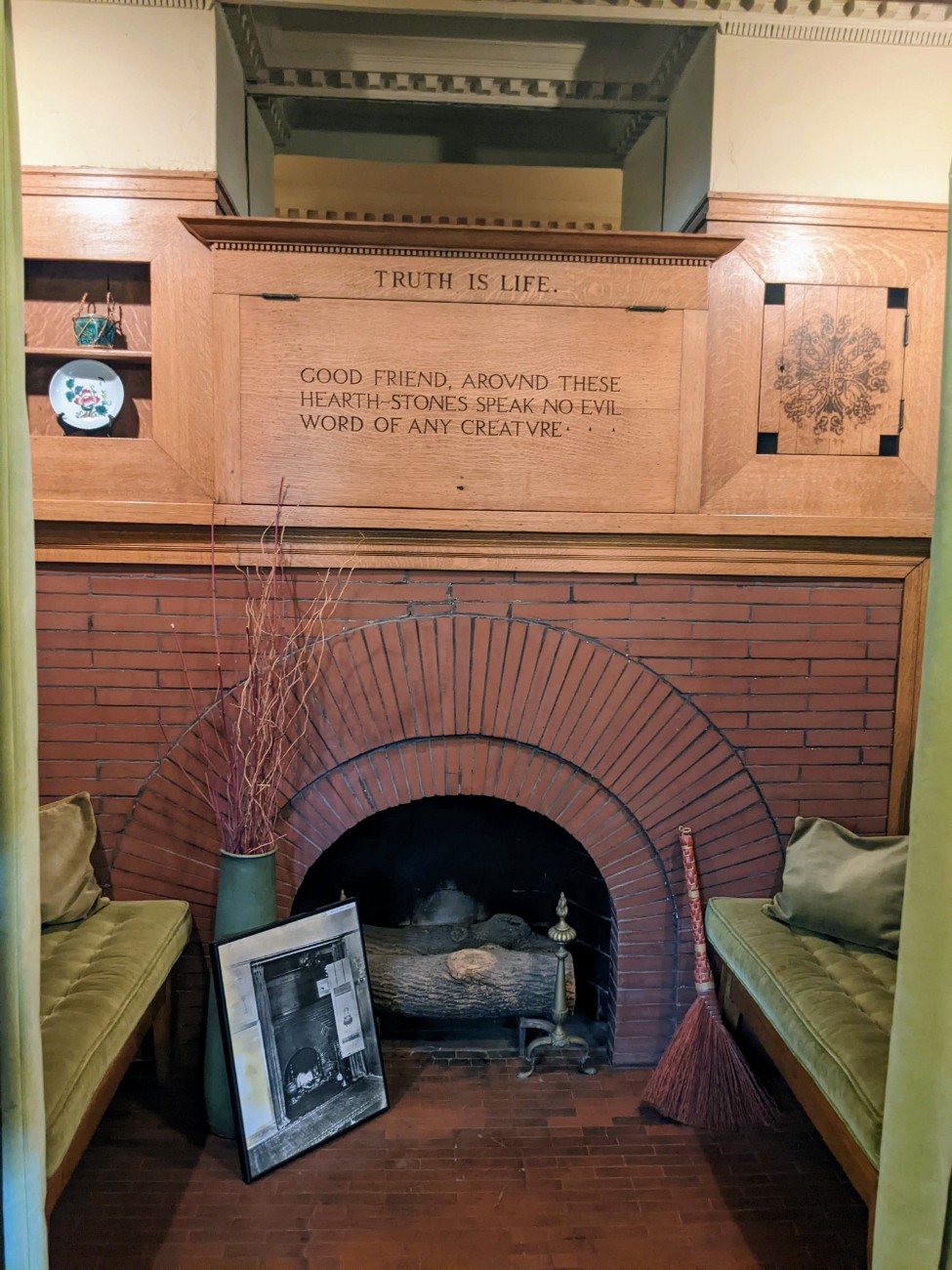
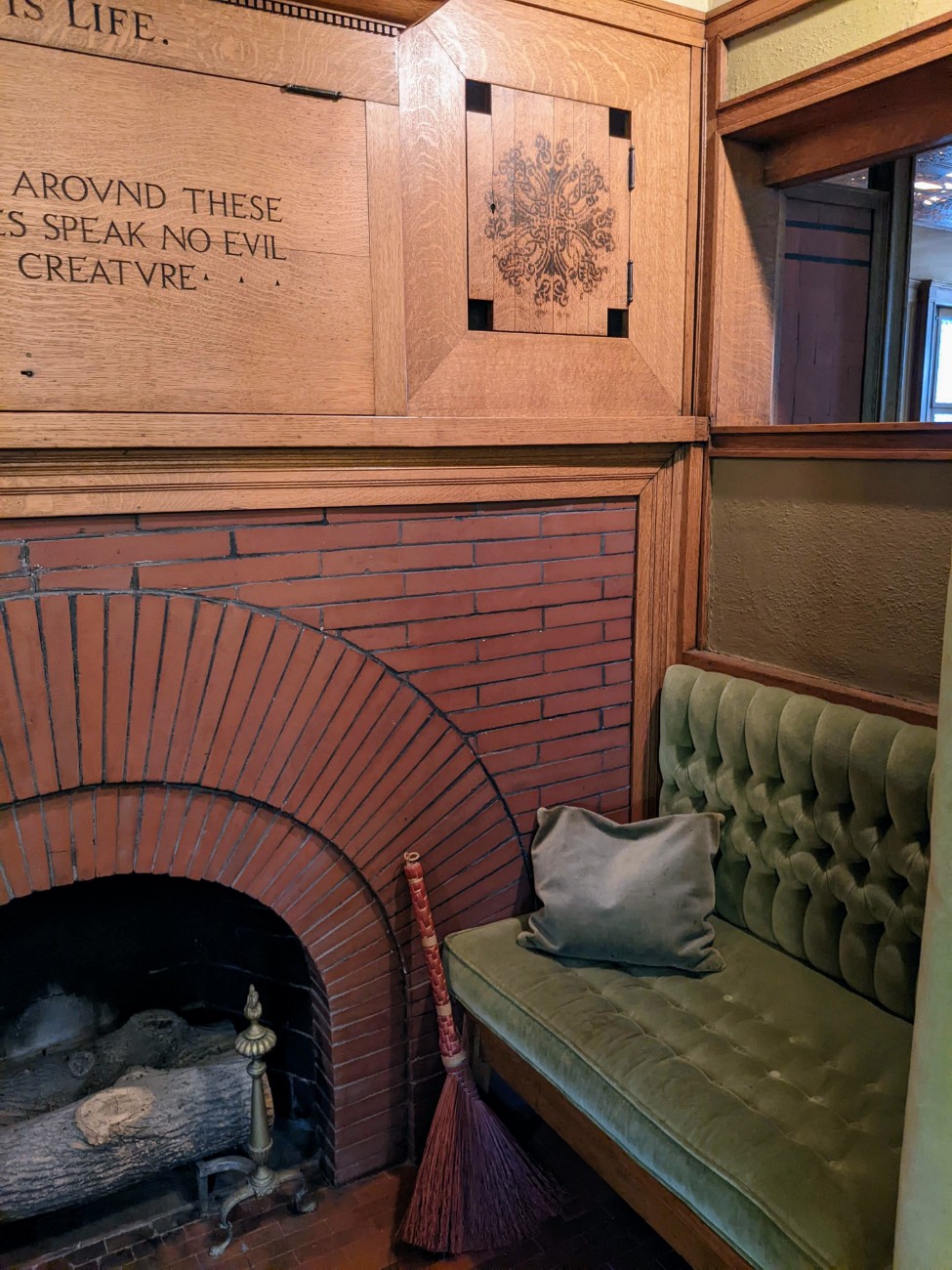
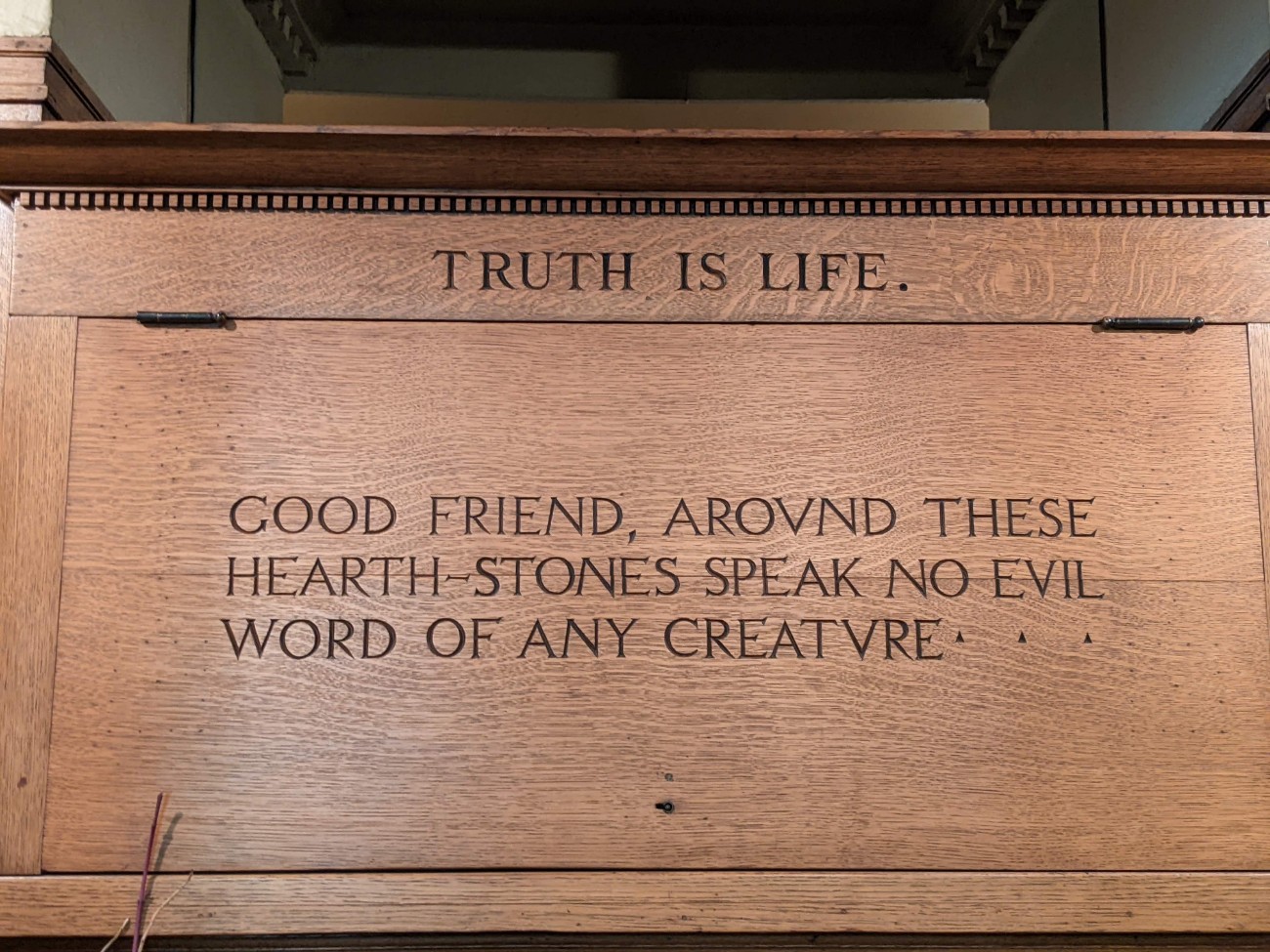
Speaking of kids, around the corner is a space with a desk and built-in shelving as a place for his kids to study. I think this was originally the house’s dining room, but don’t quote me on it.
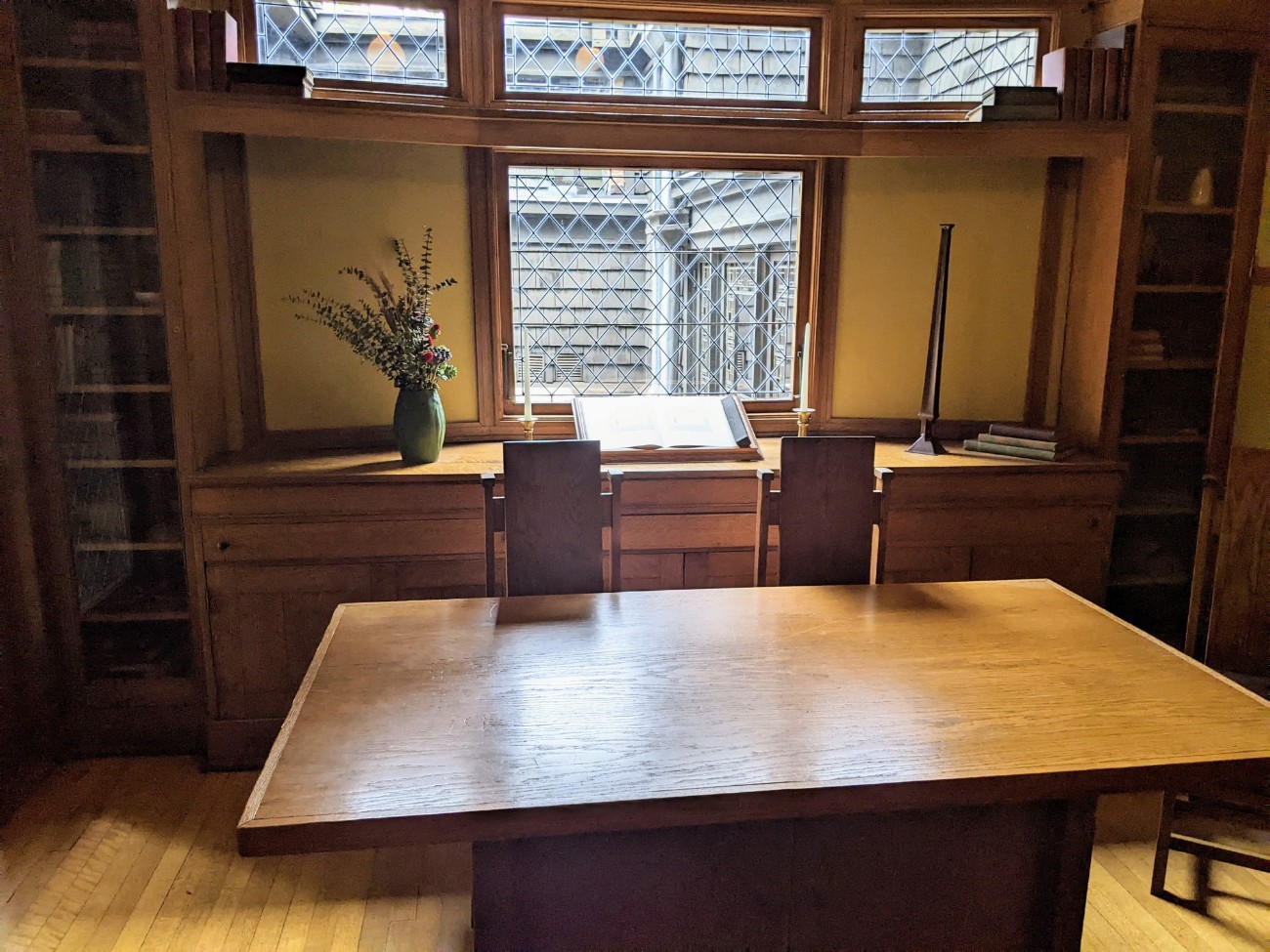
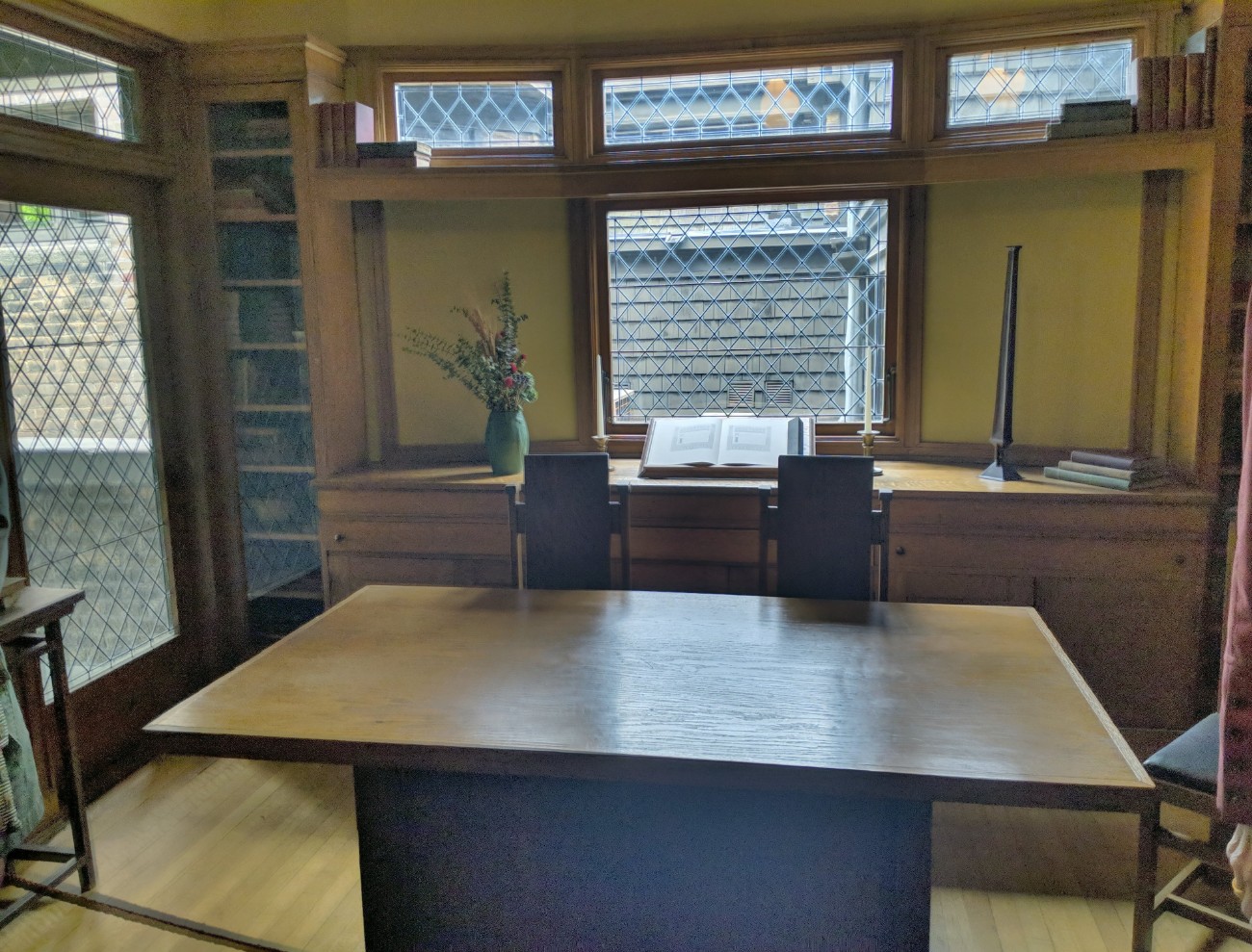
Another converted space is the large dining room, which I think used to be the kitchen. (I think – it’s hard to remember everything she said.) The dining room has a fantastic carved wooden screen in the ceiling light above the table and the high backs of the chairs create almost a room-within-a-room for the people seated.
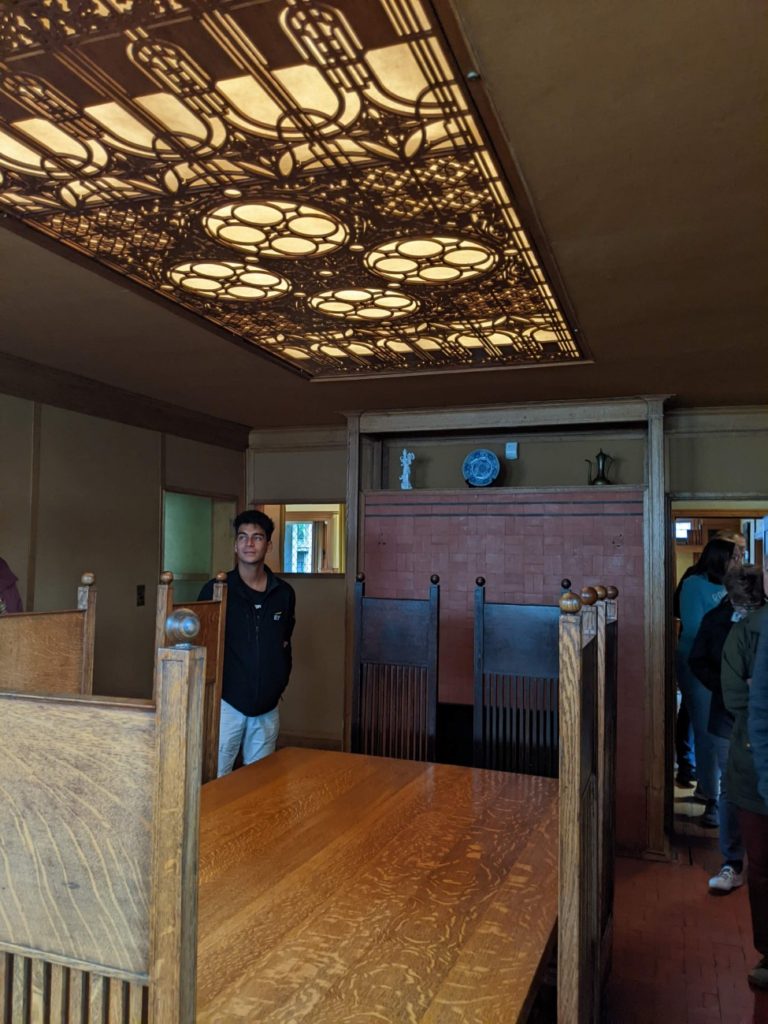
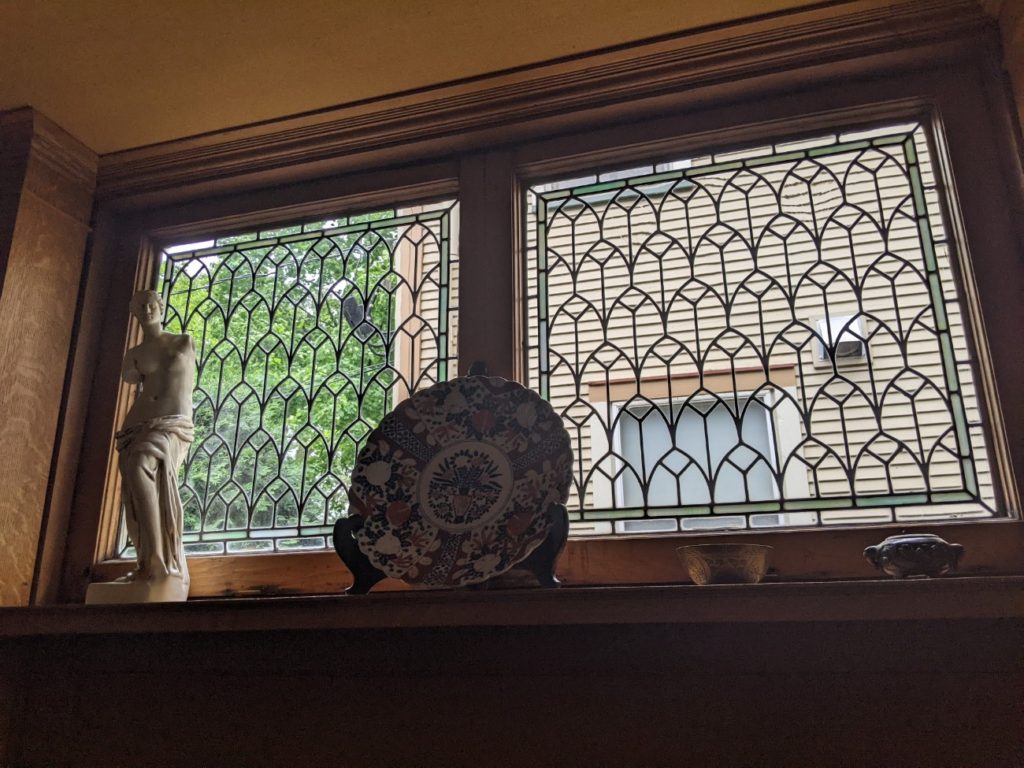
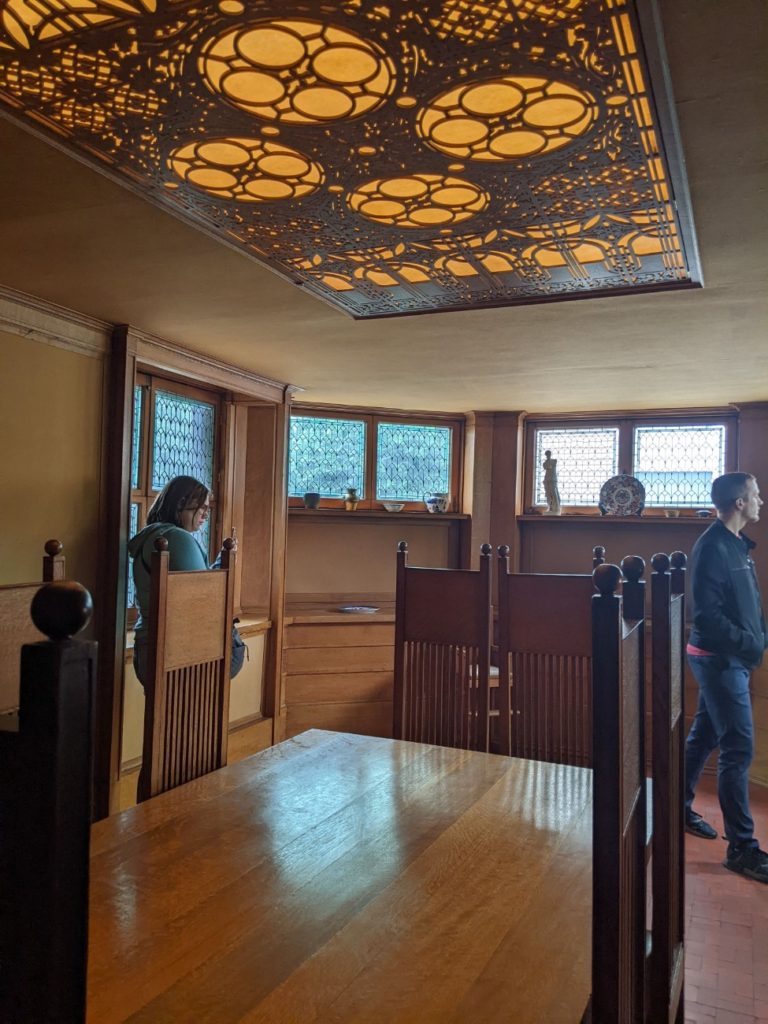
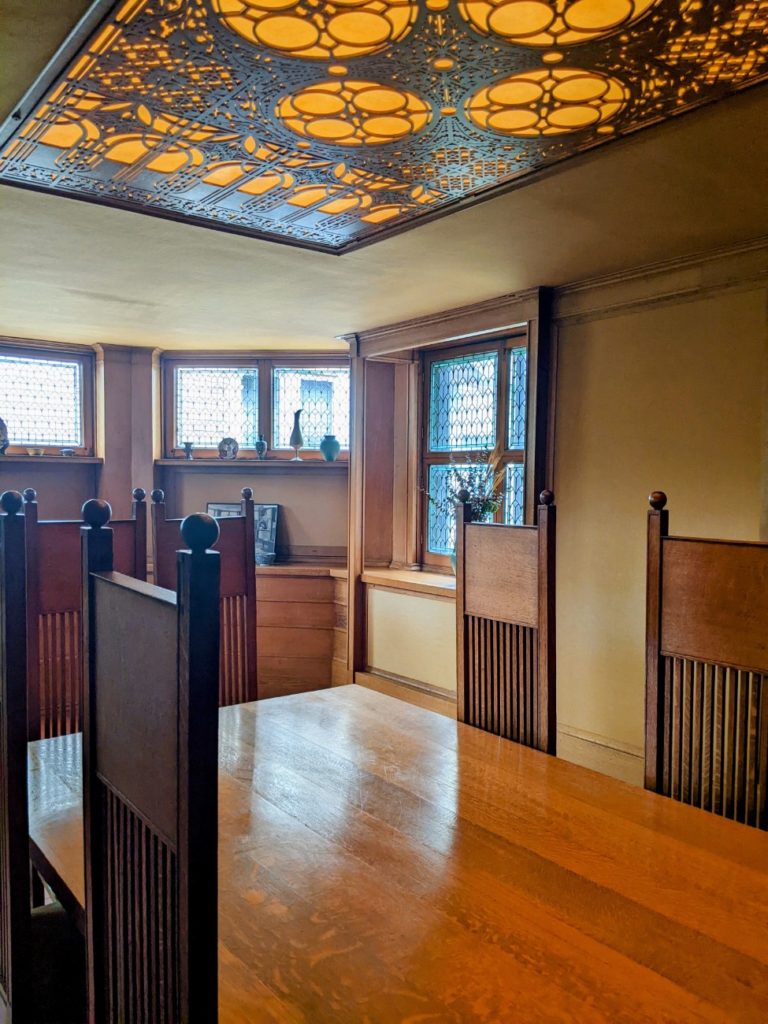
Upstairs
Next, we head upstairs to a few bedrooms and a sitting room. I’m sure sleeping arrangements were different when they lived here, but it’s currently set up as two kid’s rooms and a bedroom and bath for Frank & Kitty. Closet storage lines the walls for the kids. In Frank’s room, stunning art fills the wall below the vaulted ceiling on either side. Even the light fixtures are coordinated with the art. Then notice in the bathroom, that Frank Lloyd Wright found a solution to allow natural light into a room with no windows.
Another large room that used to be a nursery was converted to an upstairs sitting room. It’s a large open room with a low alcove on the far end.
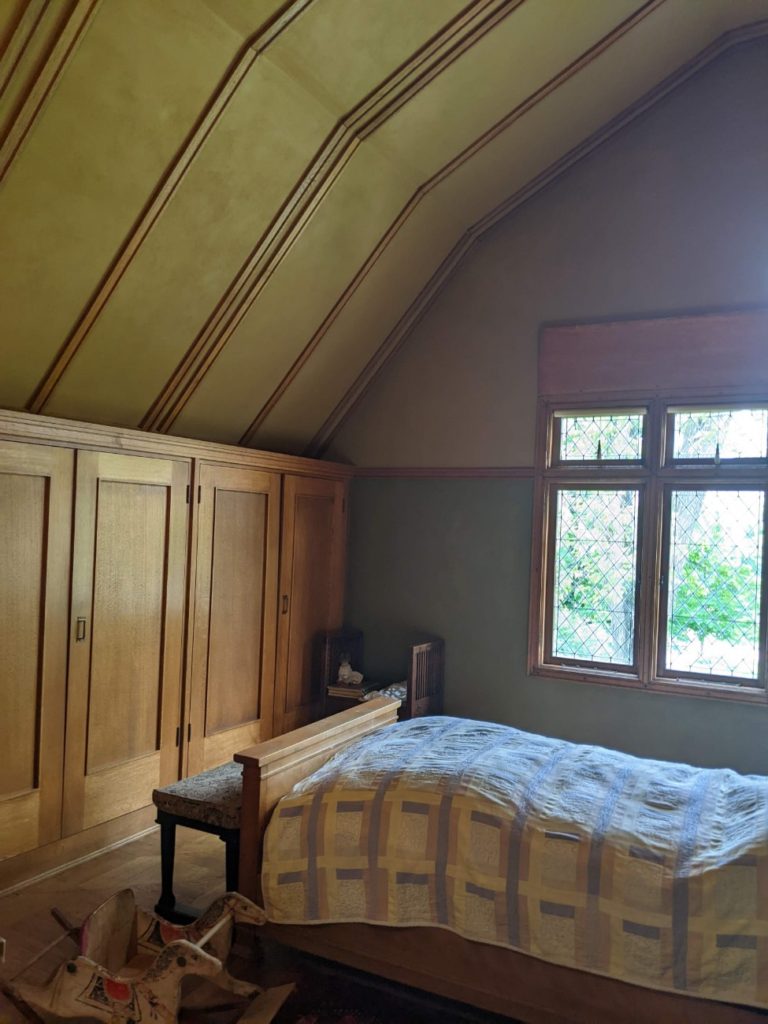
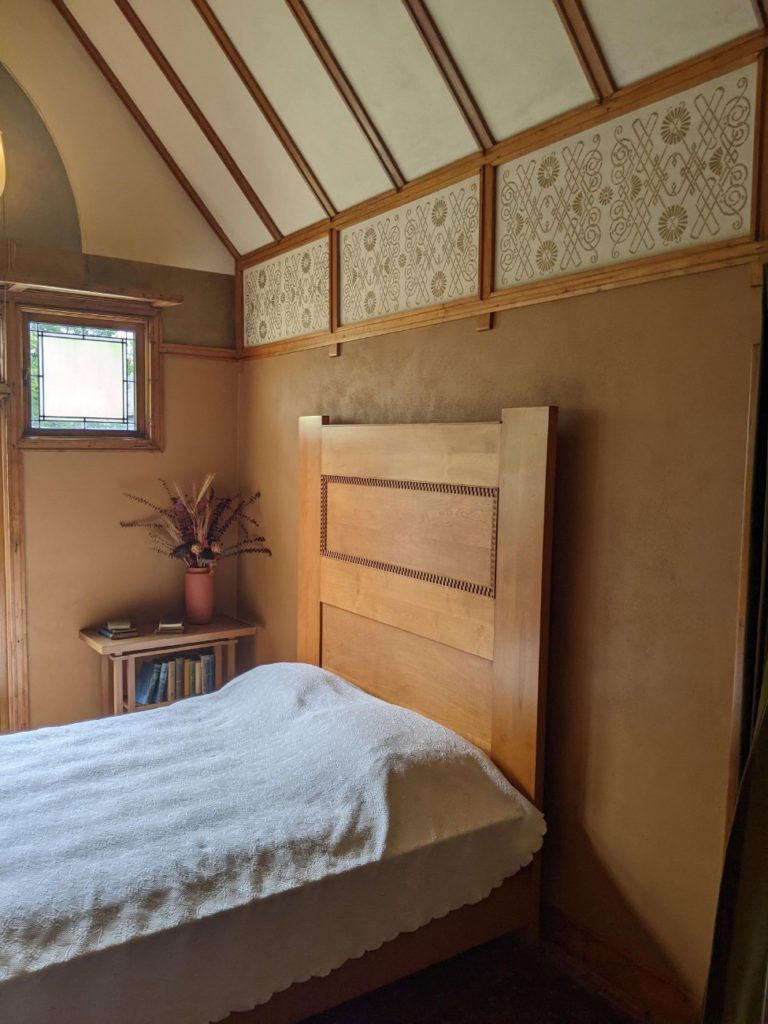
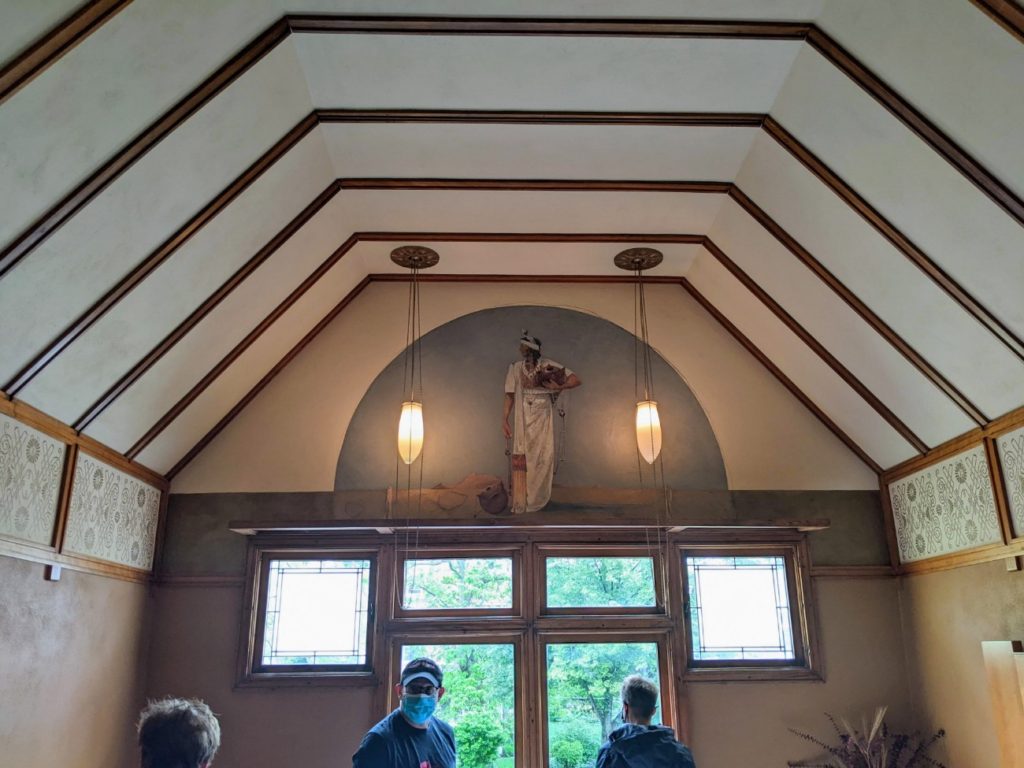
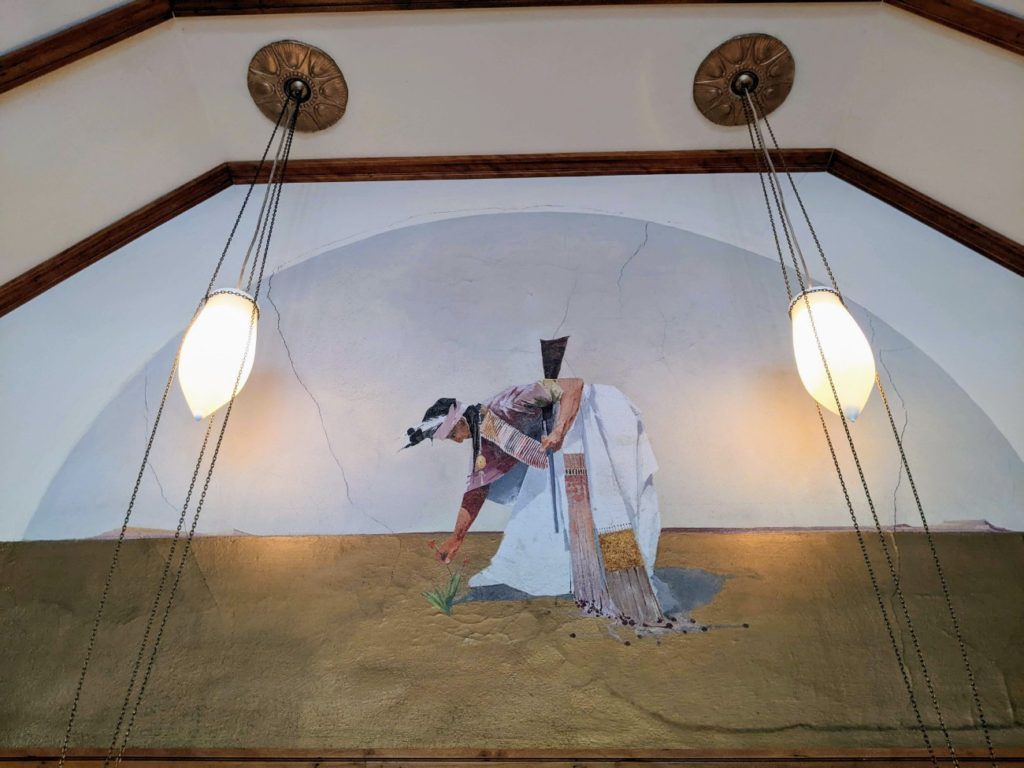
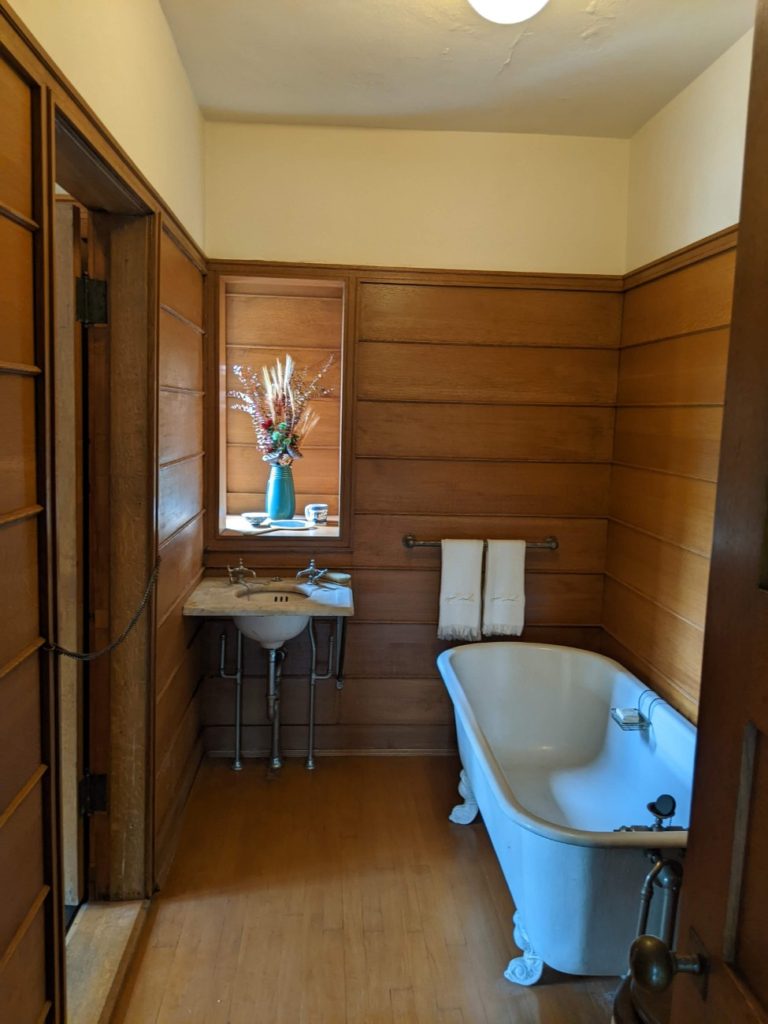
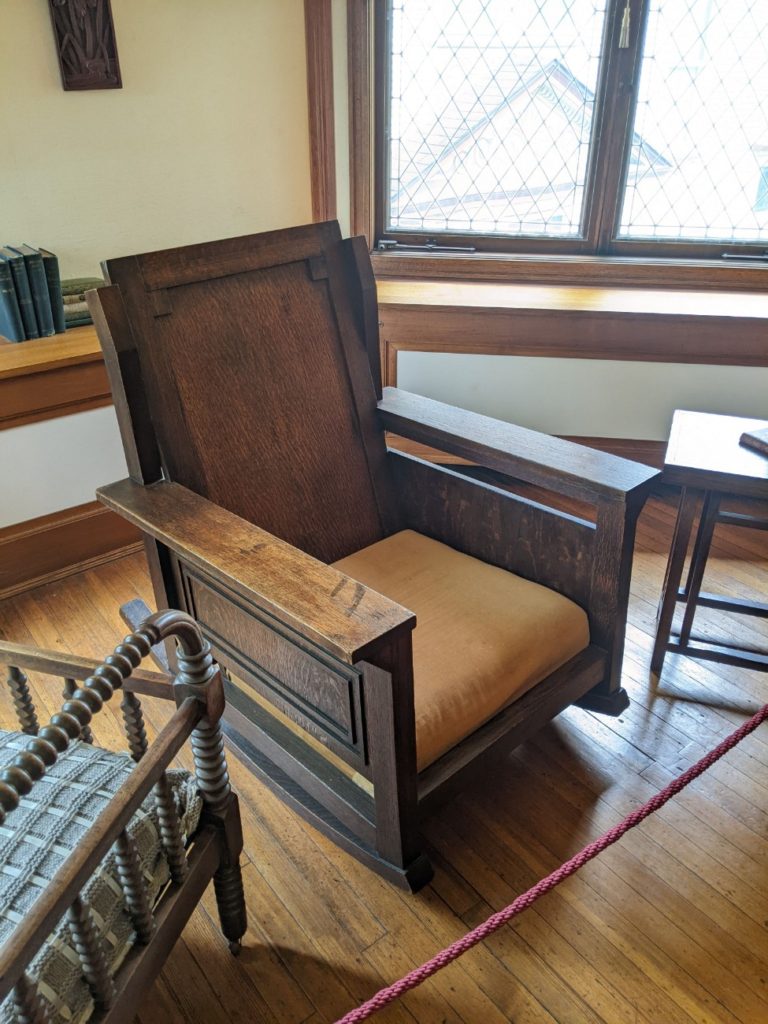
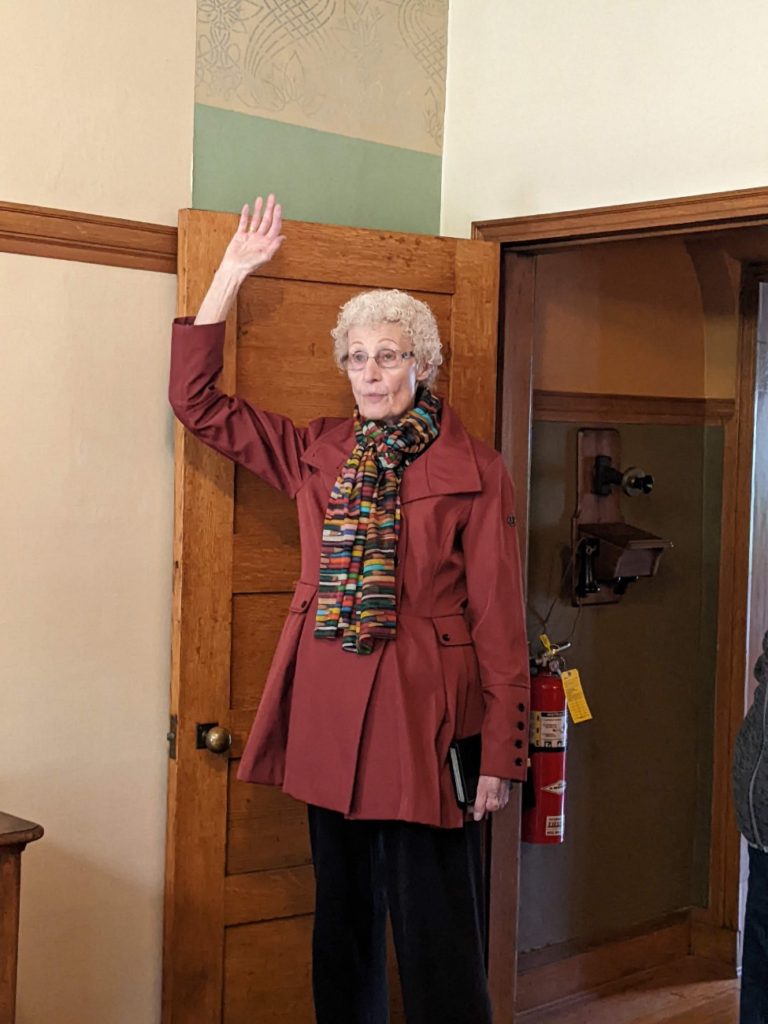
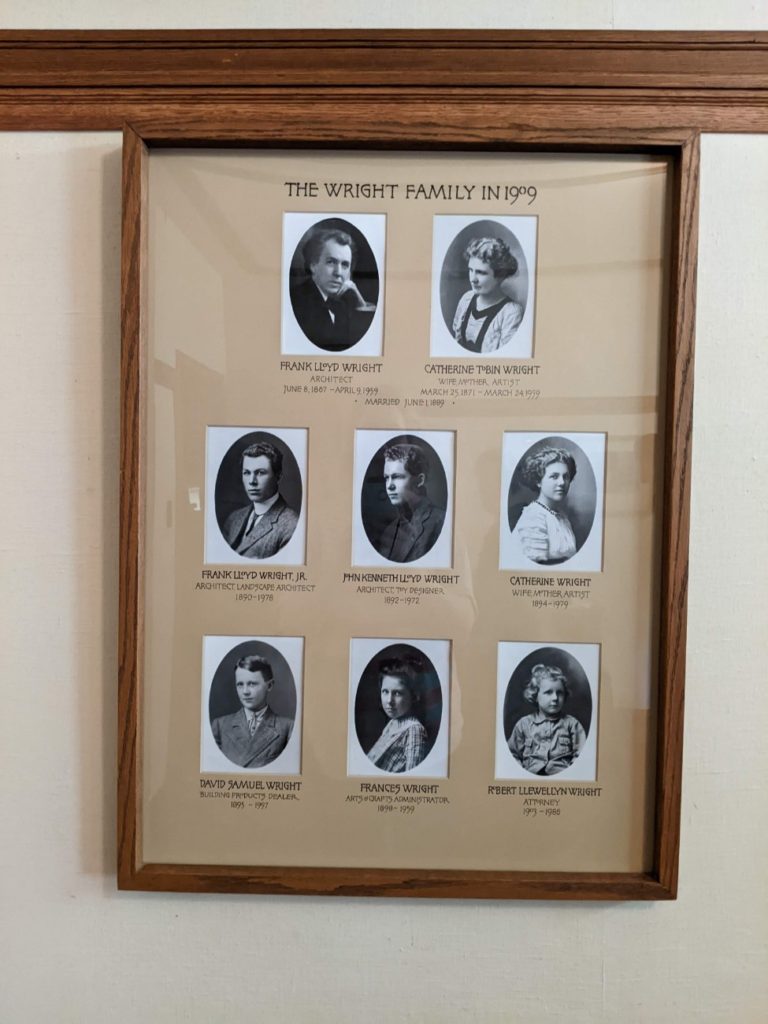
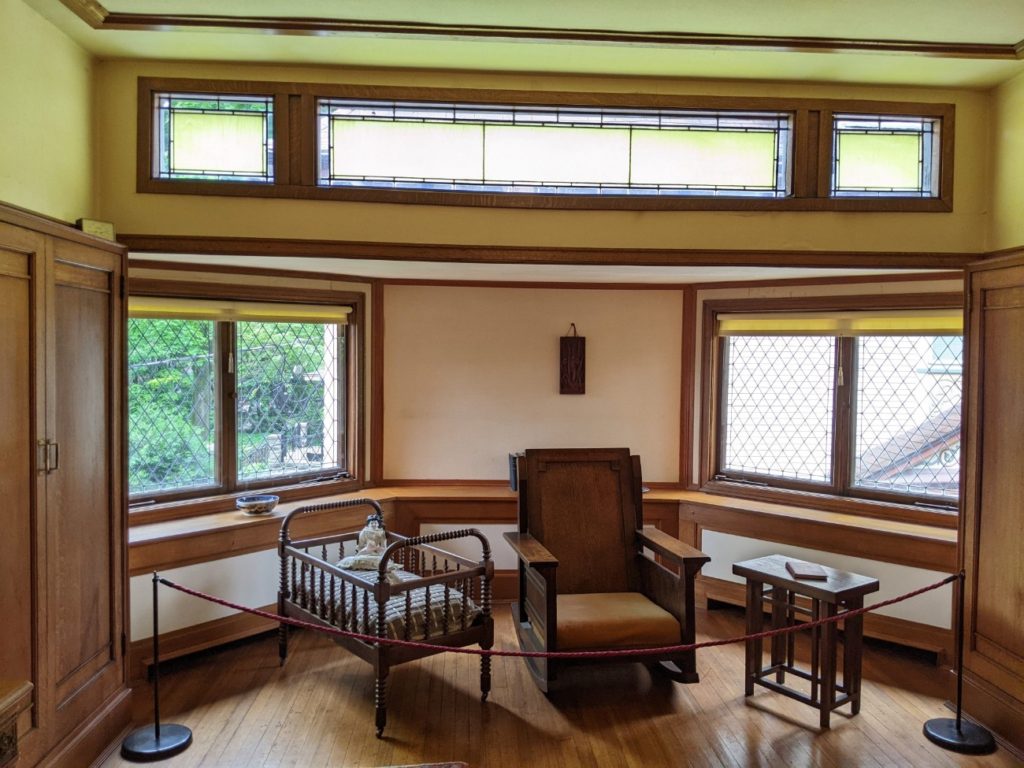
Next, down a hallway is the largest home addition, a large vaulted playroom (I think with the new kitchen underneath.) This playroom is amazing! Not only is there more exquisite art on the far wall, there’s another one of those carved wooden screens in the ceiling, this time curved to match the barrel roofline.
Then there are beautiful leaded glass windows over a wide seat/platform and loads of built-in cabinets for toys. And above the cabinets is a stage! Three levels of banisters afford kids loads of room to exercise their imaginations. Below the loft/stage is a full-size piano cleverly stuck into the wall so that just the front and keys are visible. You actually duck under the back end of the piano as you walk down the back stairs.
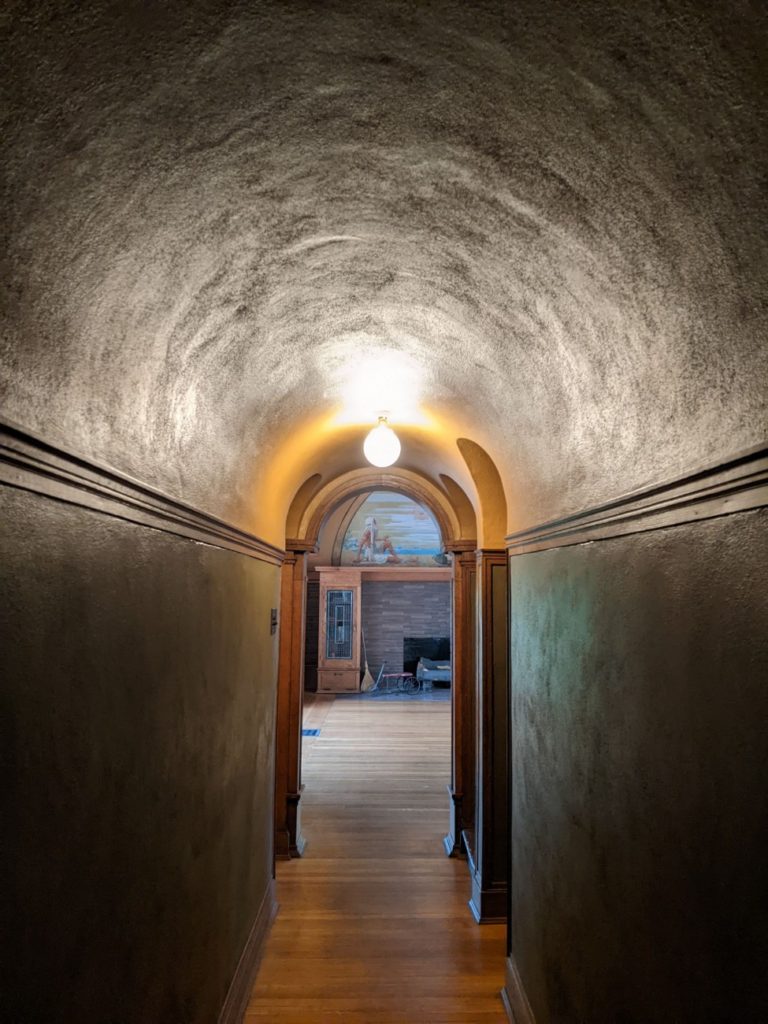
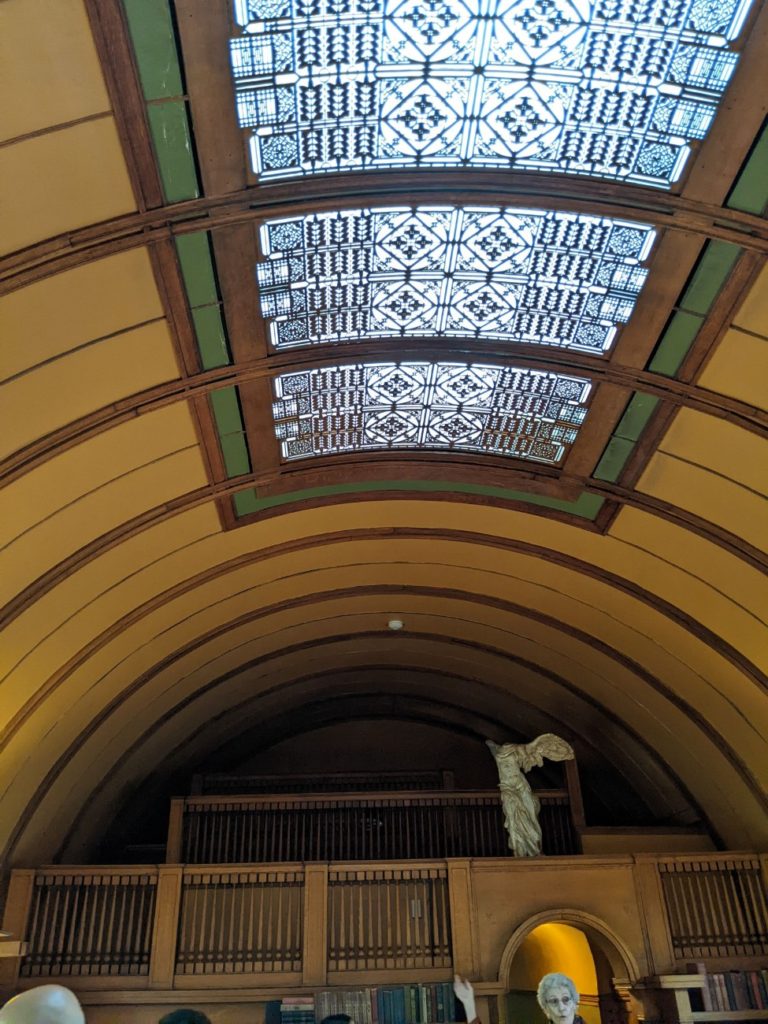
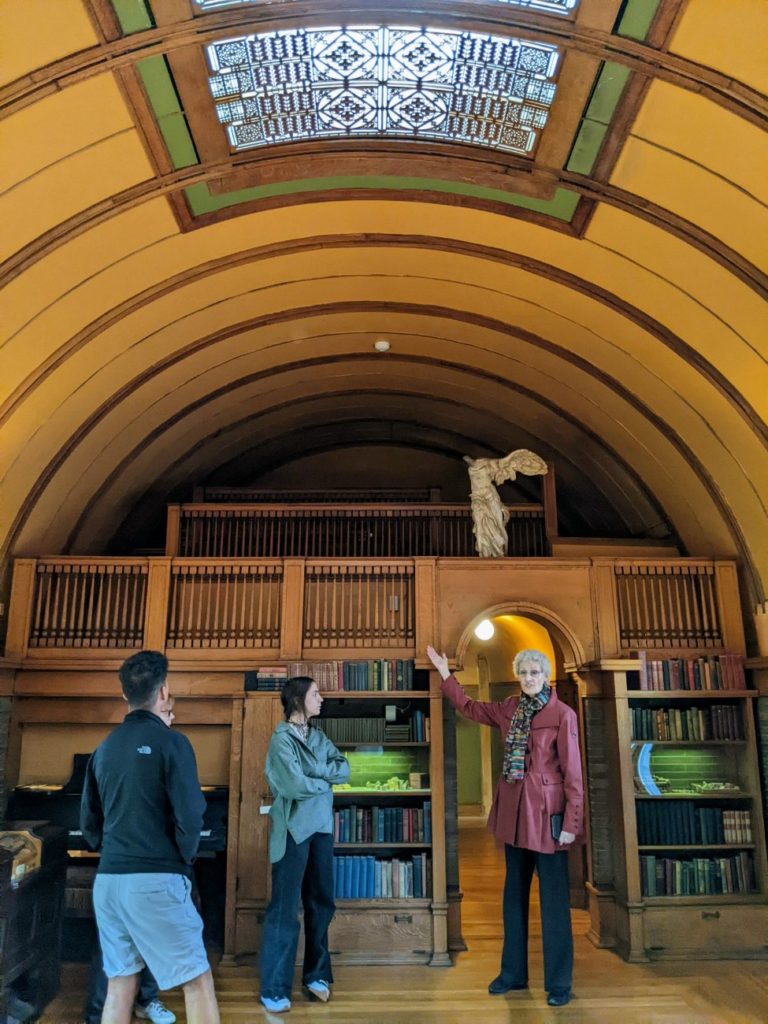
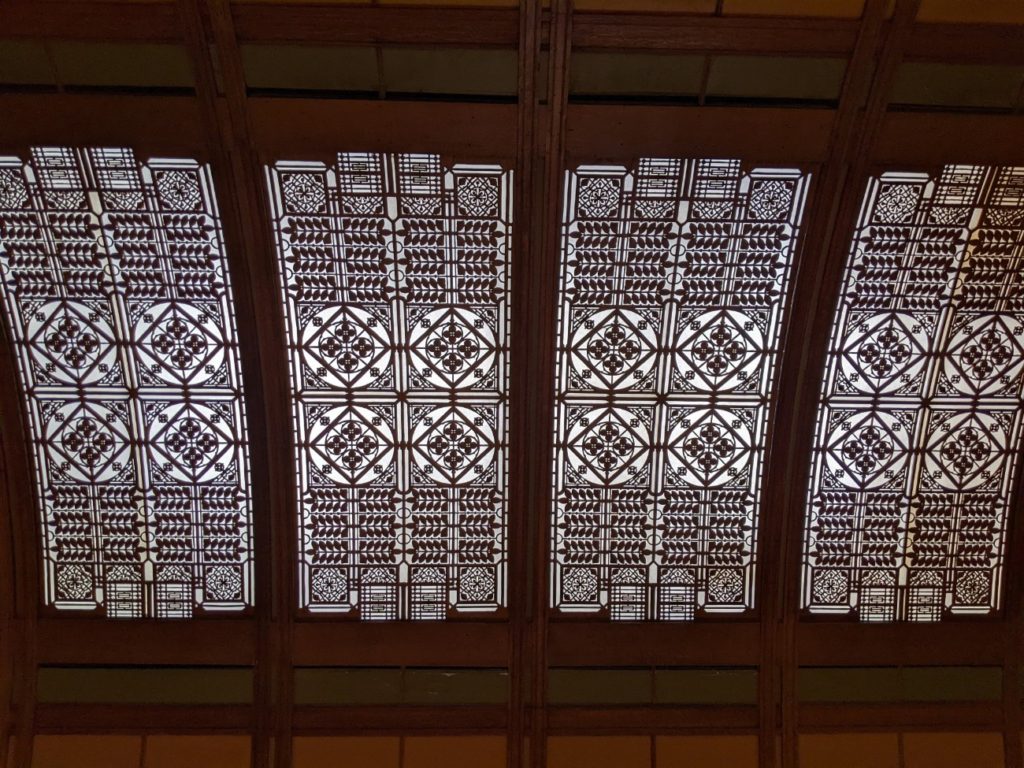
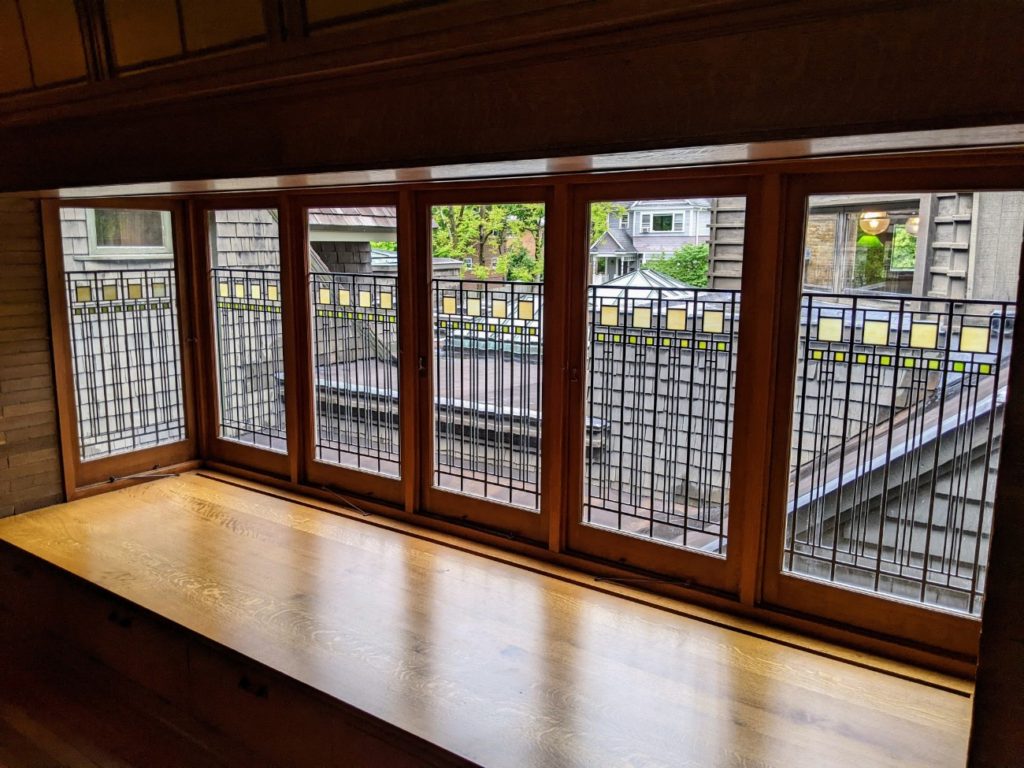
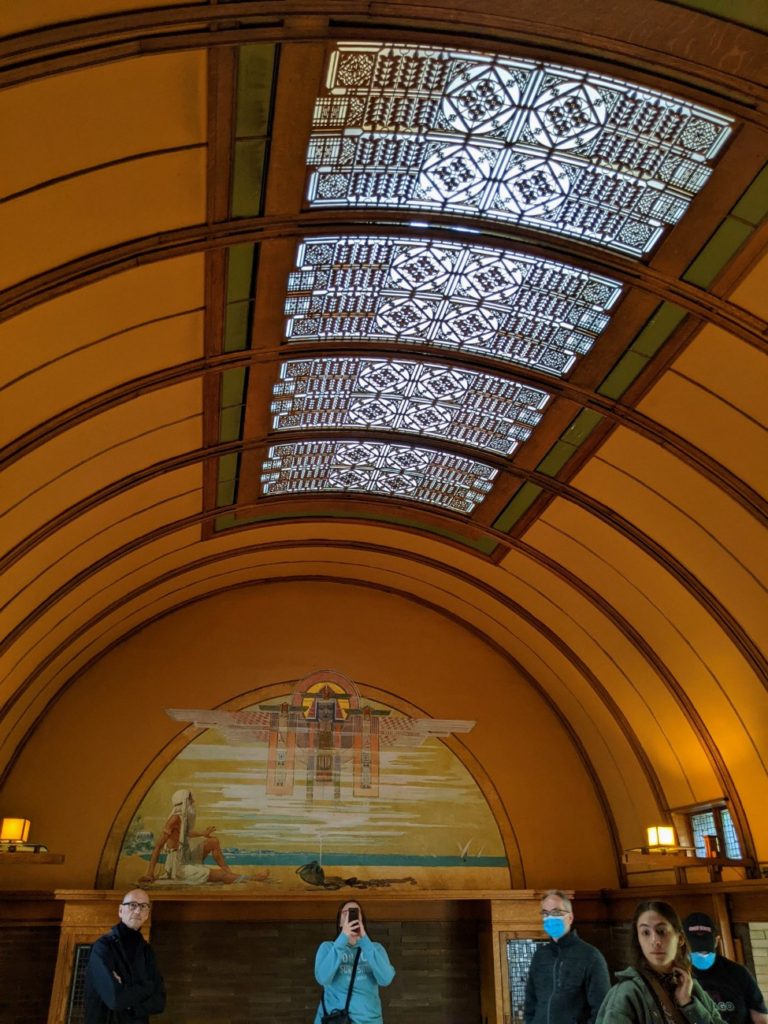
Studio Side
The group walks down from the playroom wing and through a hallway that Frank Lloyd Wright built to connect his house with his studio. You see it best when you’re on the first level going from the study to the dining room.
There’s an actual TREE that grows through this room – and it used to be a bigger one. They’ve since had to replace it. I honestly didn’t get a good look to see how this works – it doesn’t seem like there’s room for air or water to get in around it, but it must have room to grow! It’s a very unusual element in a very unusual house.
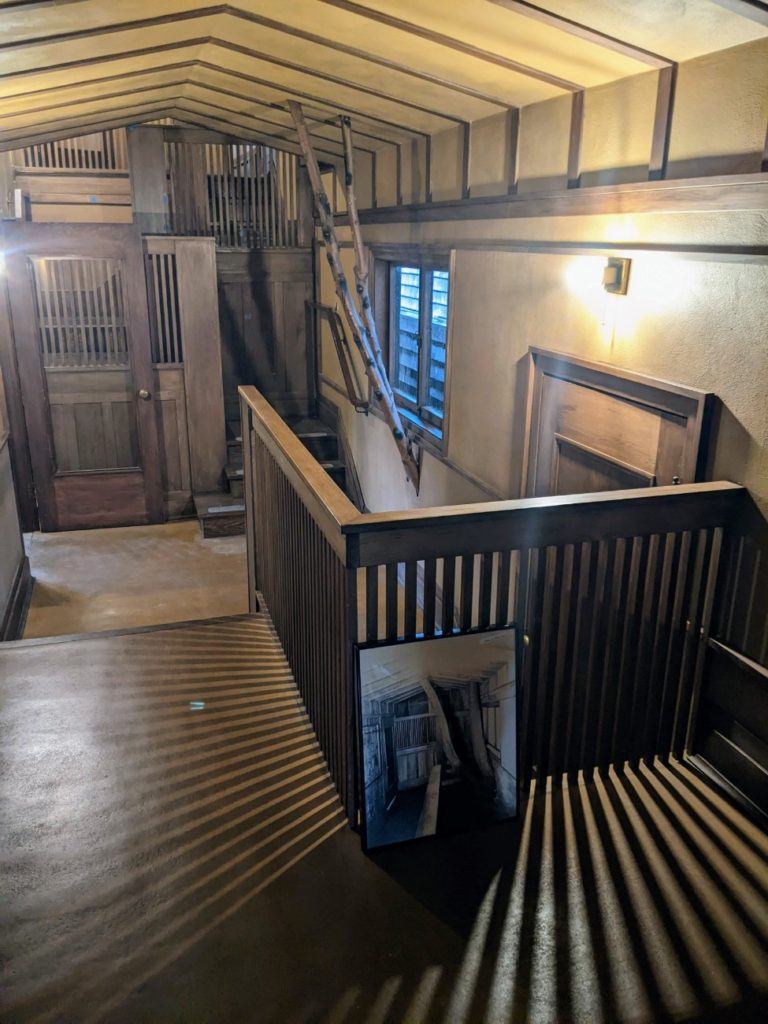
Now that we’re in the studio, we get to see some really fantastic Frank Lloyd Wright wow-factor stuff. Entering the octagonal space, we see loads of natural light for the drafting tables below and as always, lots of built-in storage. Above it all is a cantilevered balcony, supported by chains and counterweights from above instead of pillars from below.
On the near end is a large brick fireplace with a repeating bas-relief design. There’s also a model of one of Wright’s other Chicago-area houses, the Robie House.
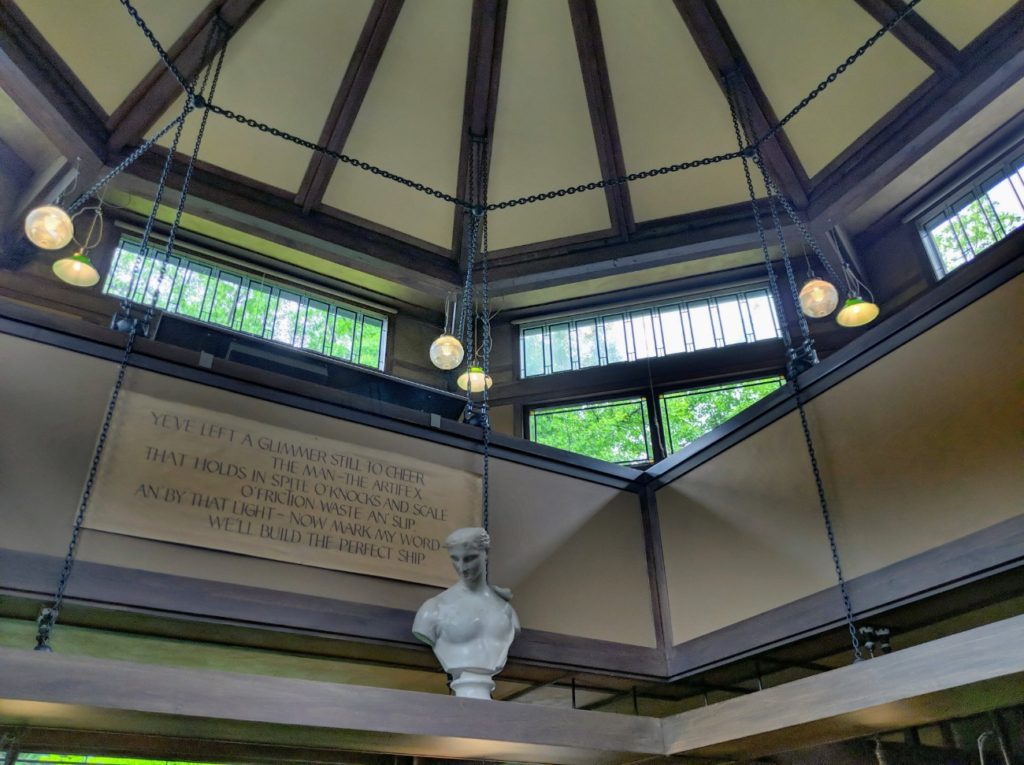
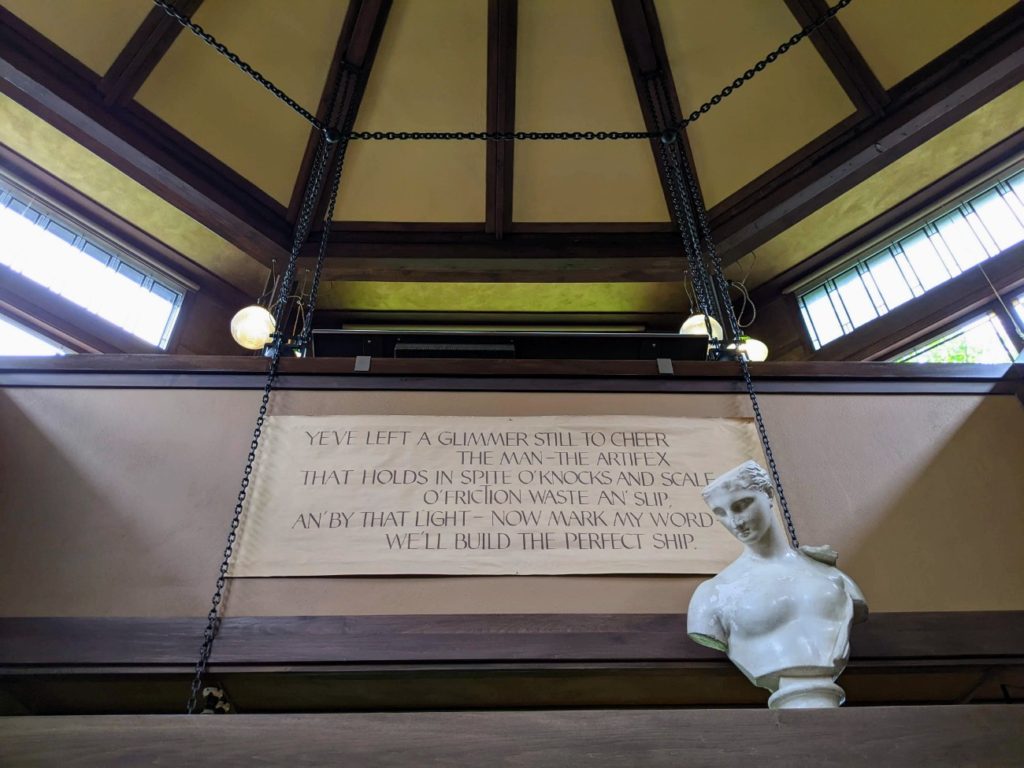
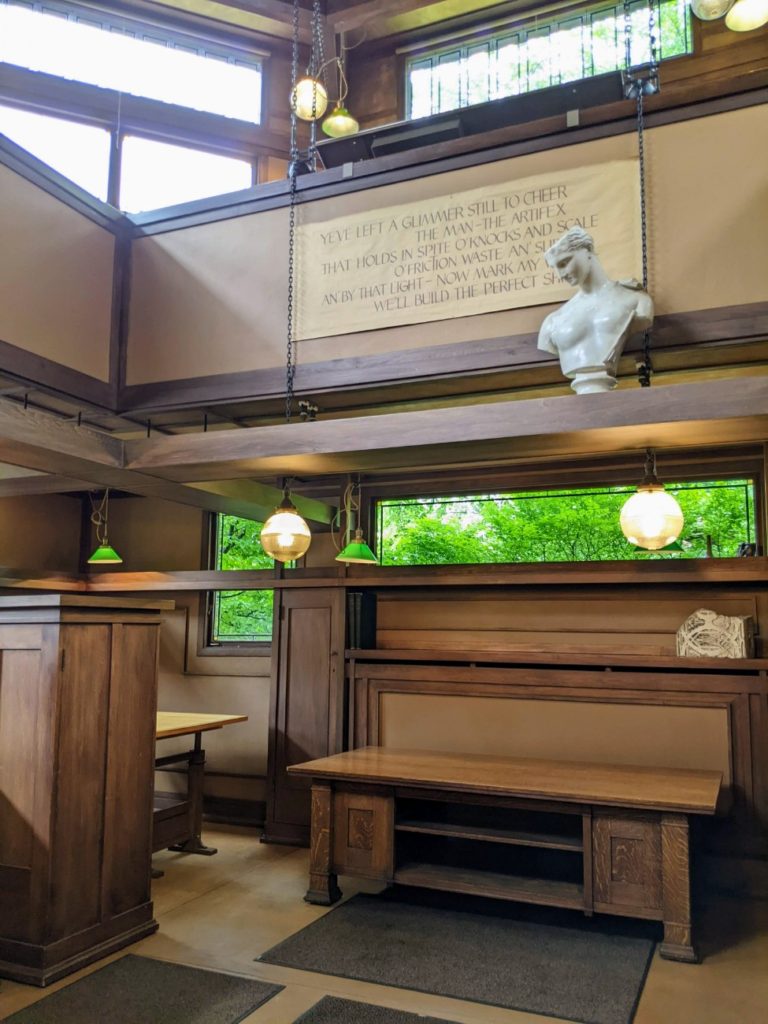
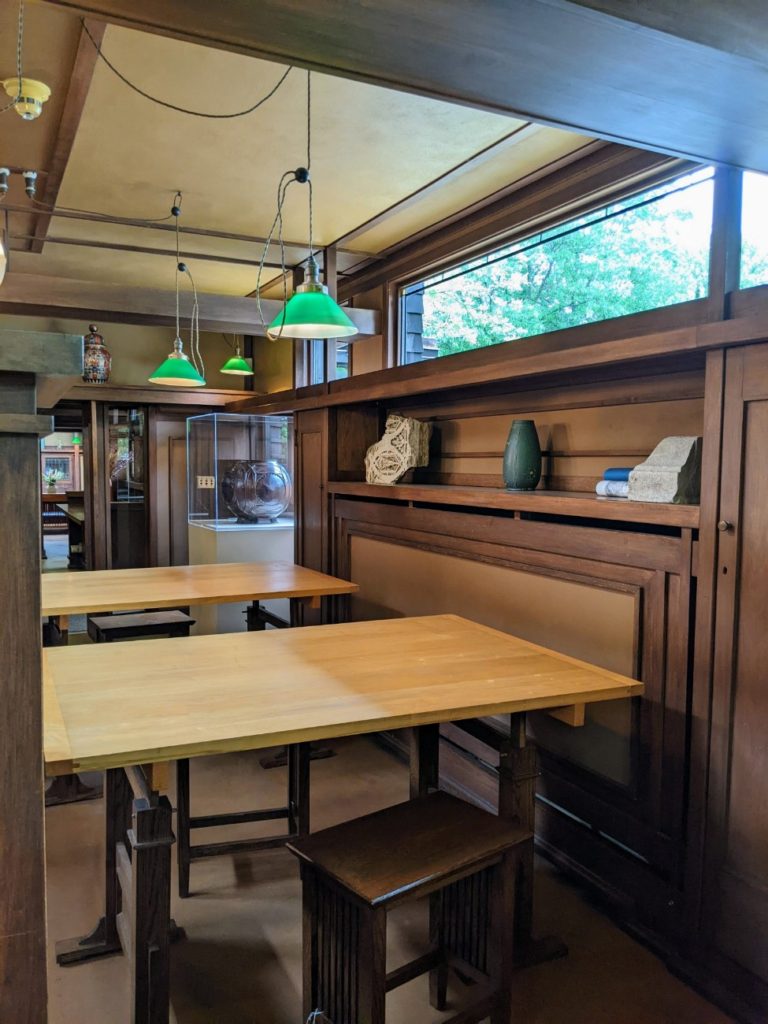
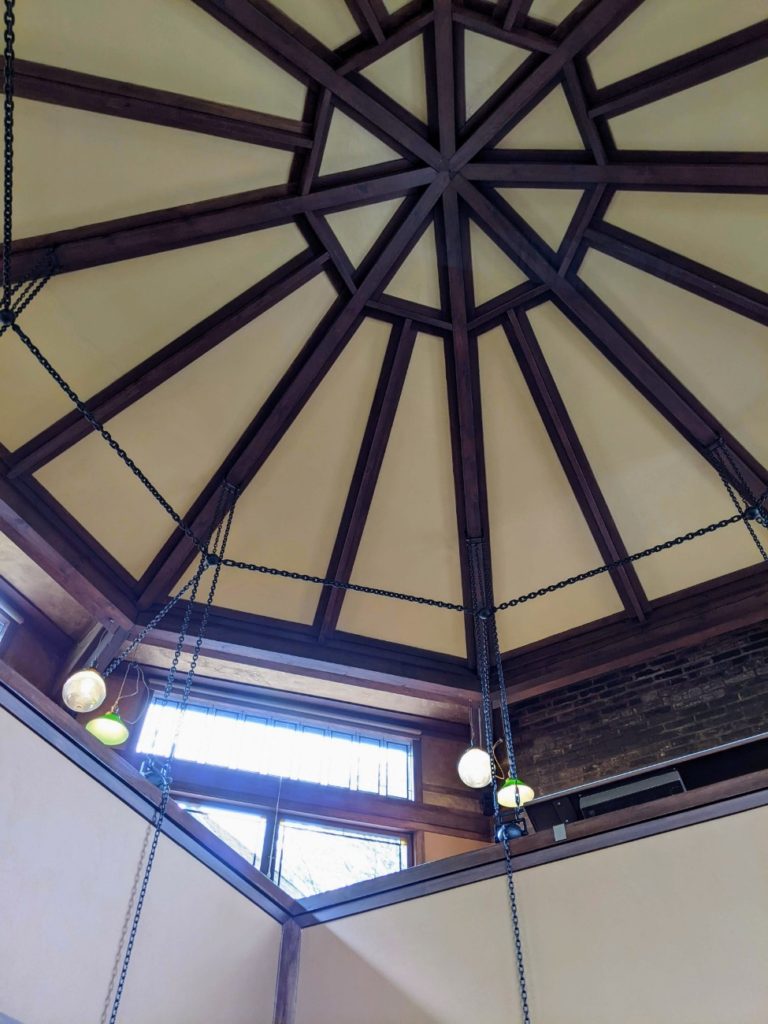
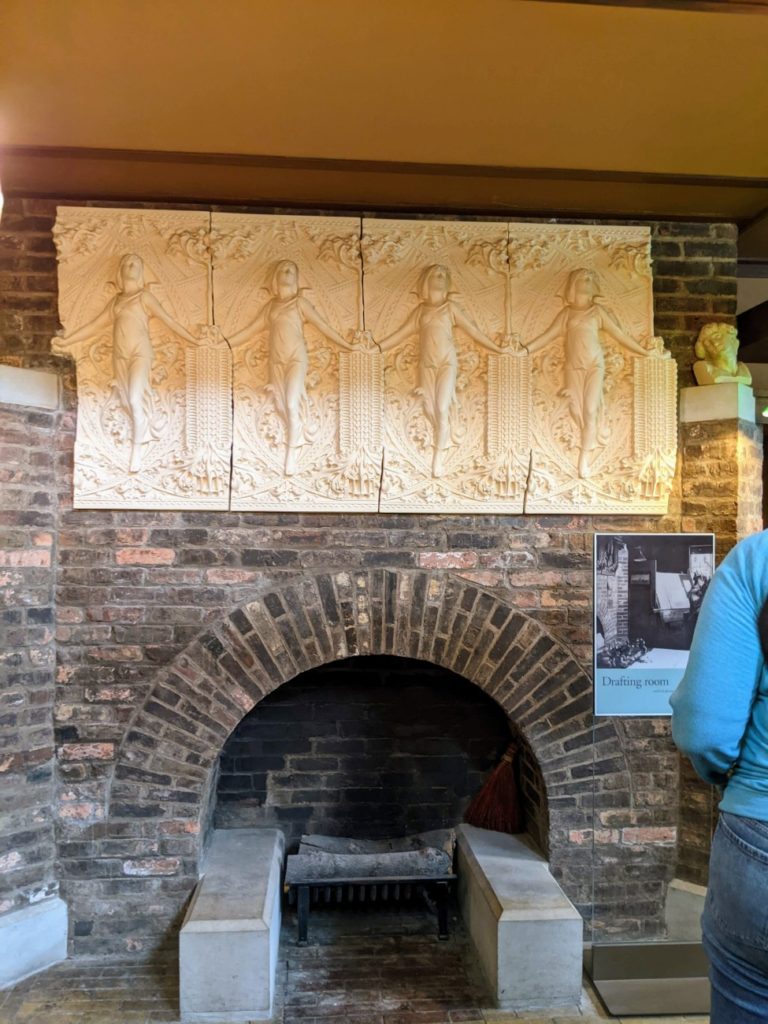
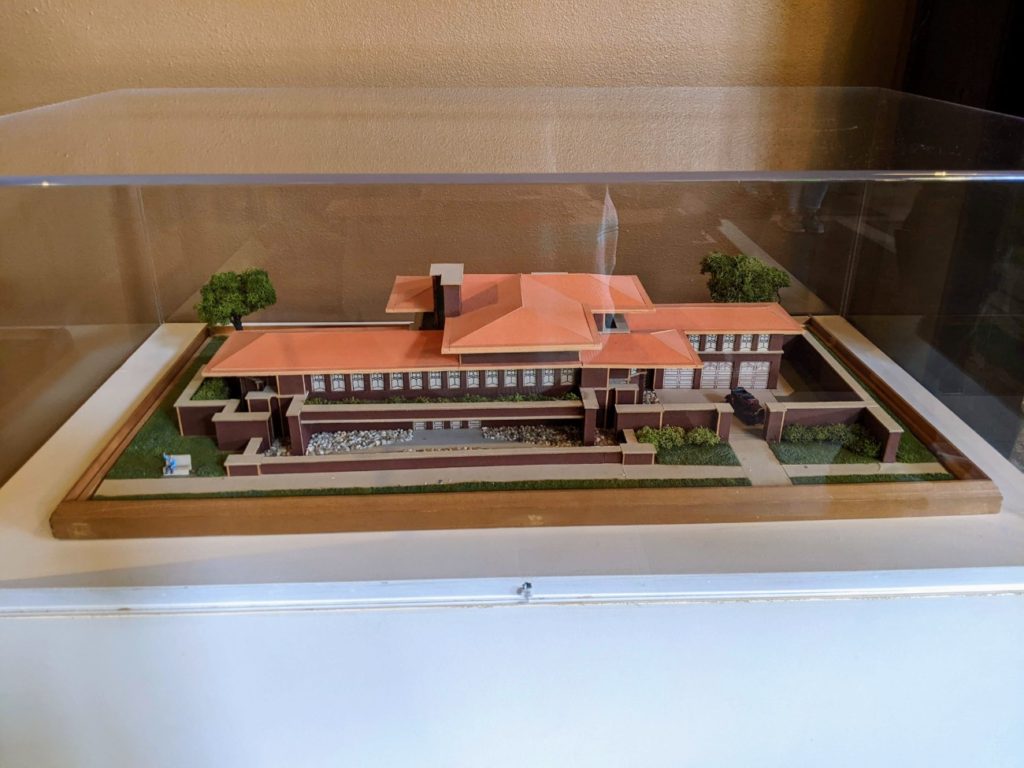
Reception Area
Past the studio (which we have essentially entered from the back) is the street-side front door of the studio and a reception area. Here, instead of one grand front door, two opposing doors lead into a waiting room with a large display desk. Tons of natural light shines in from the front and jaw-droppingly gorgeous glass panels are overhead.
Just off the front room is a room for an administrative secretary, complete with its own custom (uncomfortable) chairs, large desk, glass windows, and sculptural artwork.
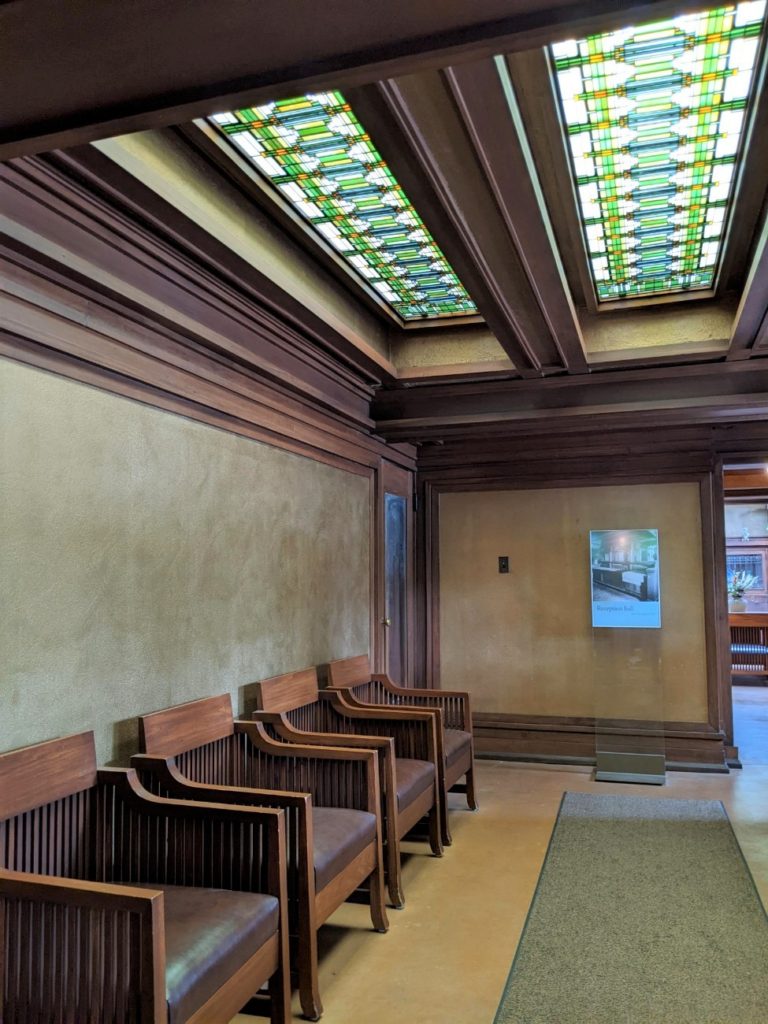
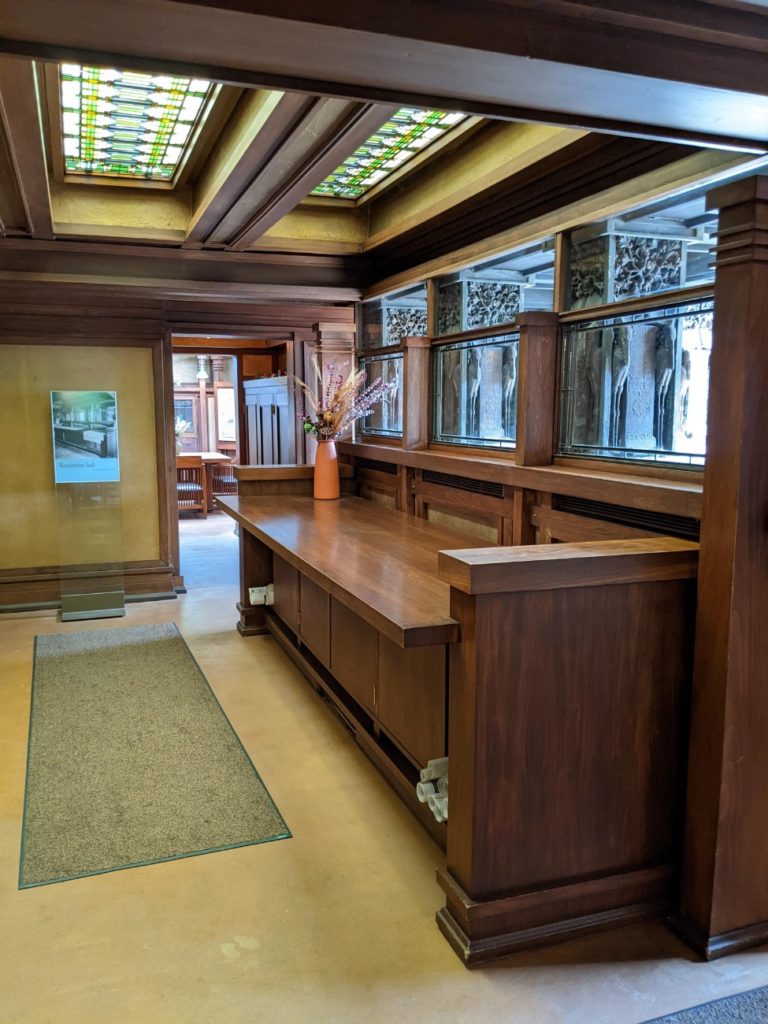
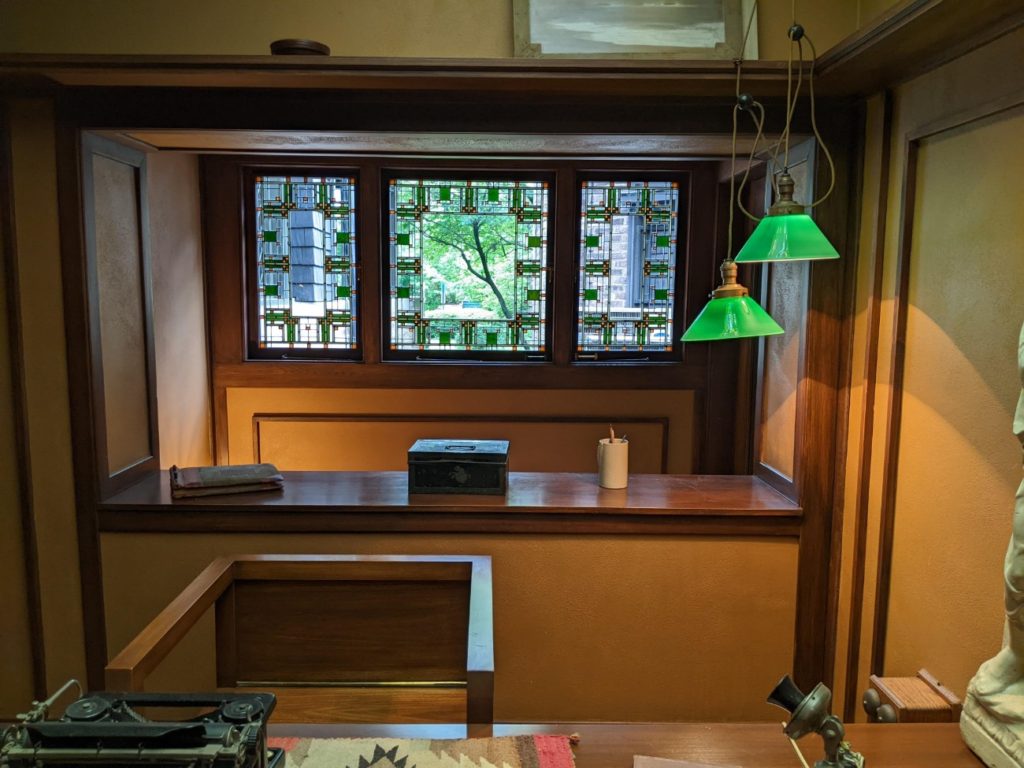
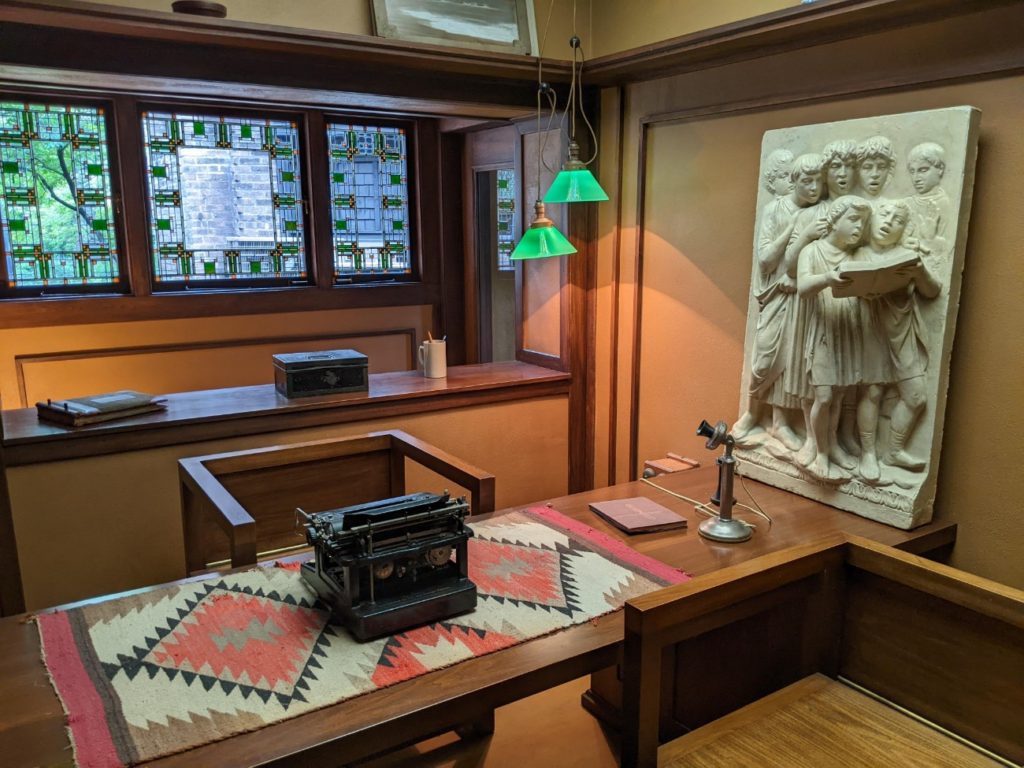
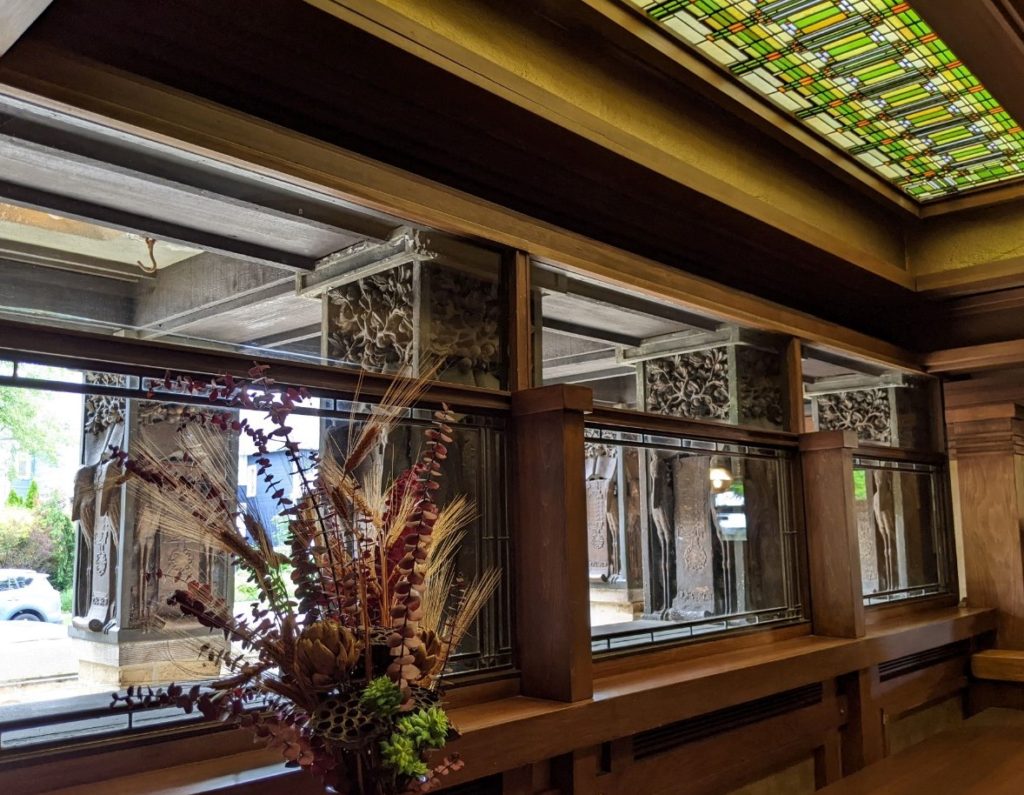
On the other side of the reception hall is a small octagonal consulting room. Storage along the walls would hold samples while Lloyd Wright and his client would sit at a table in the middle to start the planning process.
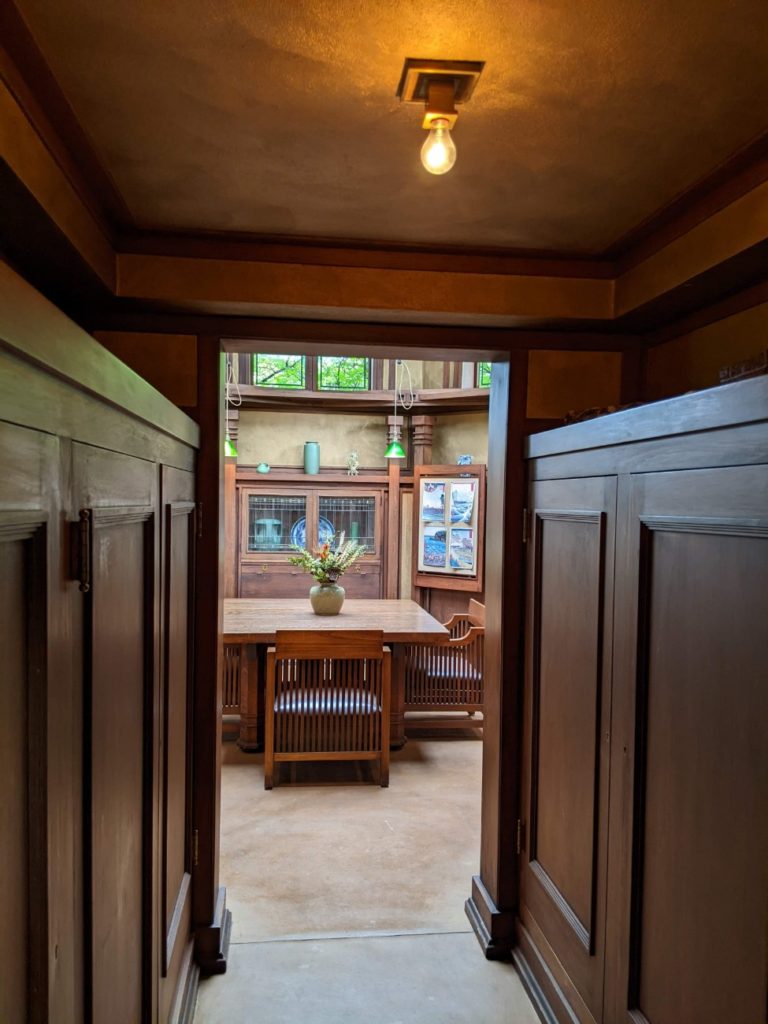
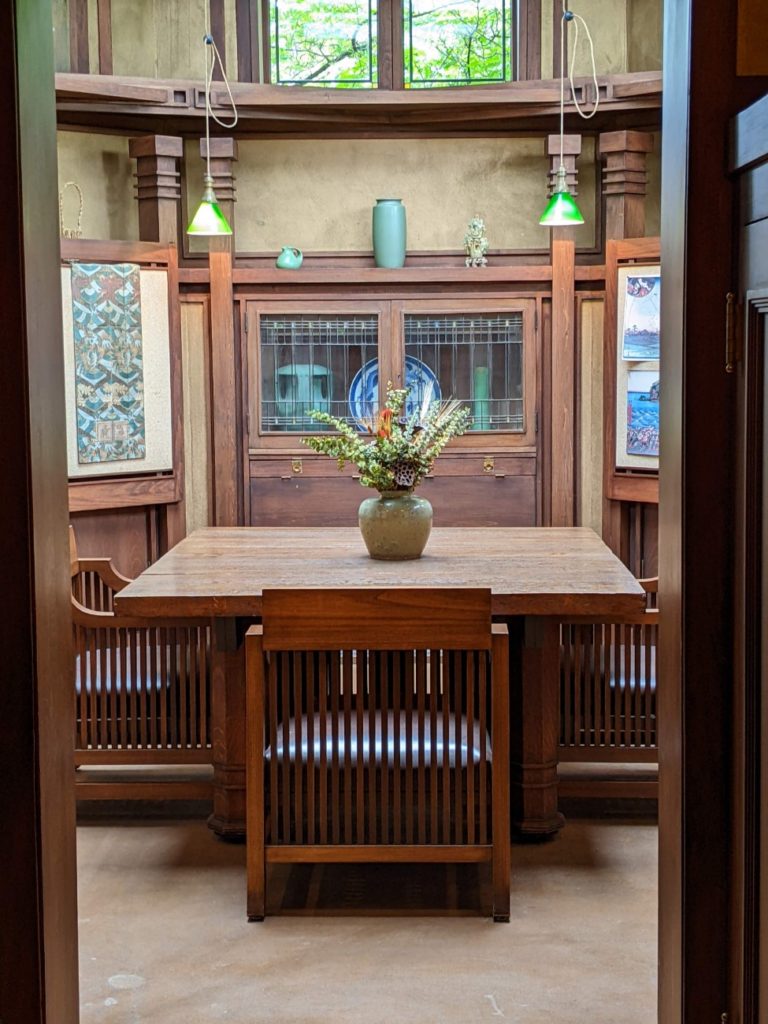
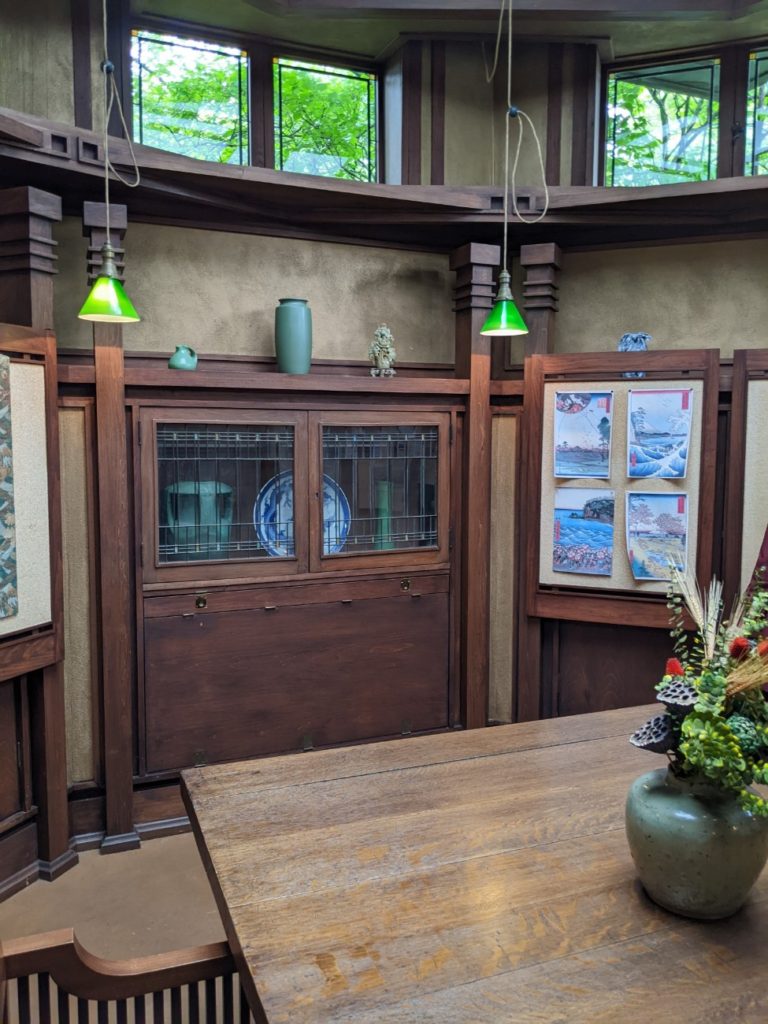
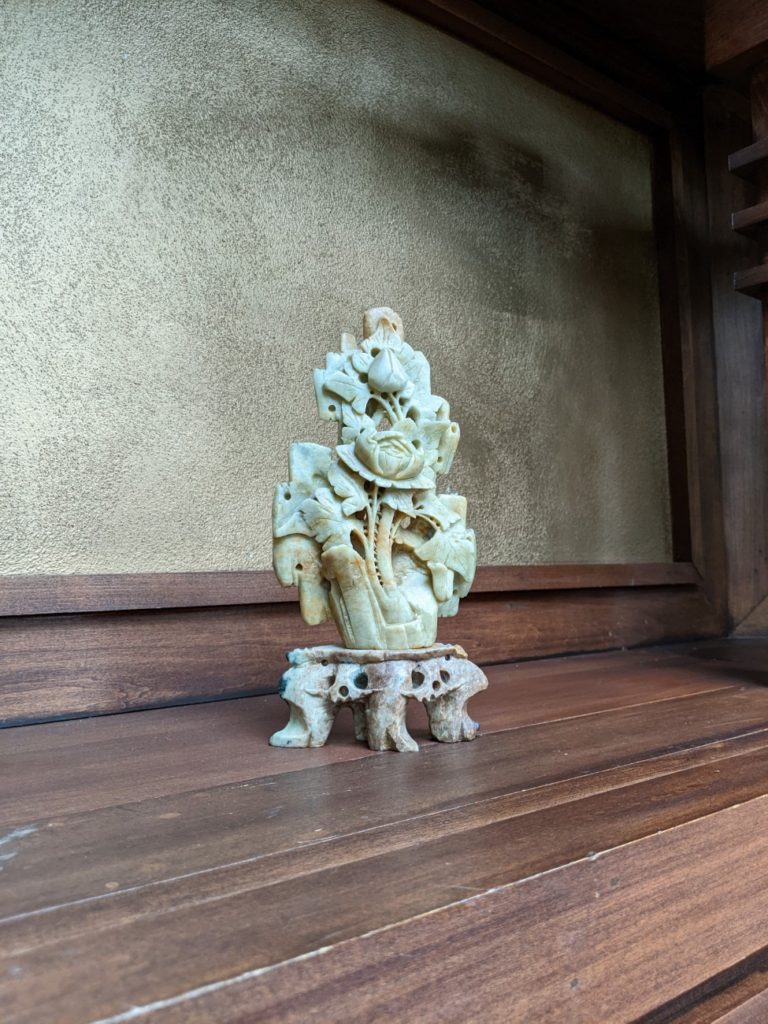
Outside
Finally, our tour group exits through the studio door, built to wow the public from the street. Frank Lloyd Wright uses balance and symmetry (almost) to give clients options as they walk to the front door. Two paths come from the street to meet in front of eight carved pillars and partial pillars. From there, you choose one of two doors to enter the reception area. It’s all about a path of discovery instead of a prescribed “come this way only” entrance.
Besides the heavily-carved pillars, there is a stylized “Frank Lloyd Wright” carved nameplate, just so you know you’re in the right place. And there are two large-scale sculptures of a crouching male figure above either side of the doorway. While they are identical, Frank Lloyd Wright turned one of them a quarter turn so they wouldn’t look exactly the same from the front. There is such a thing as too symmetrical.
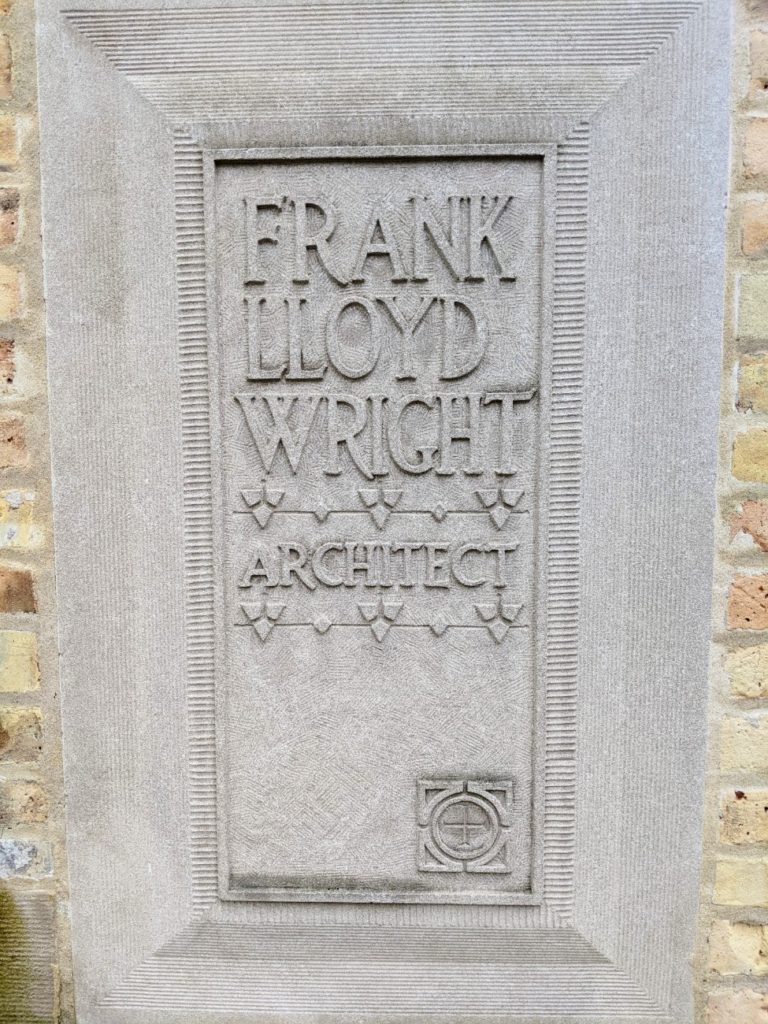
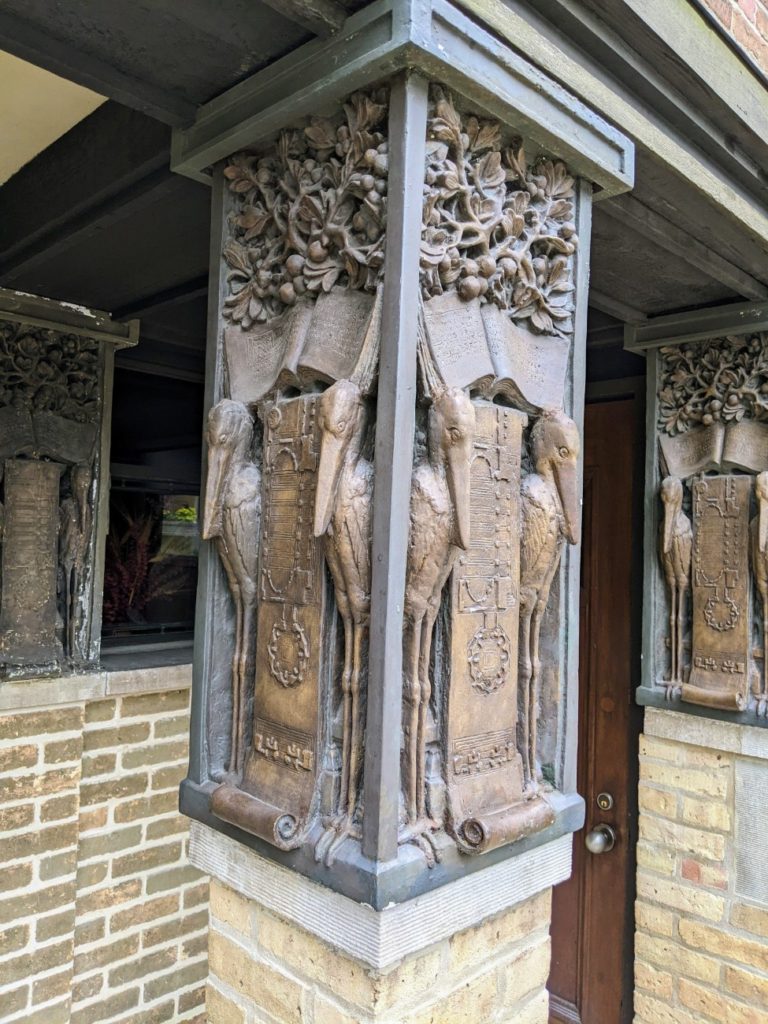
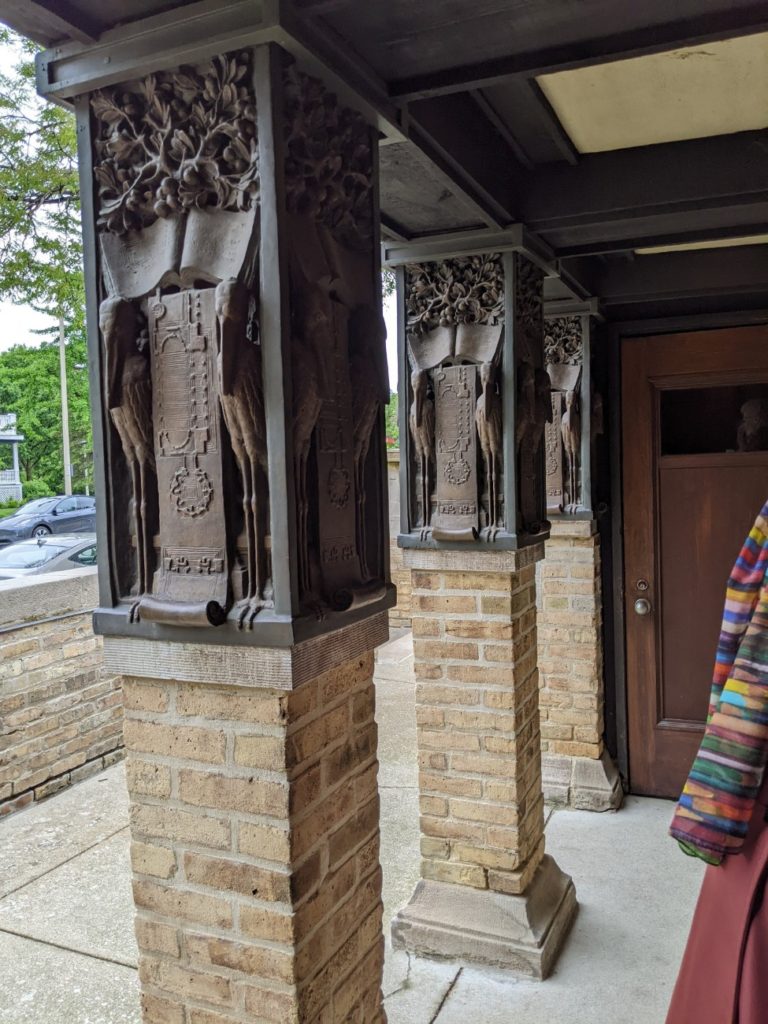
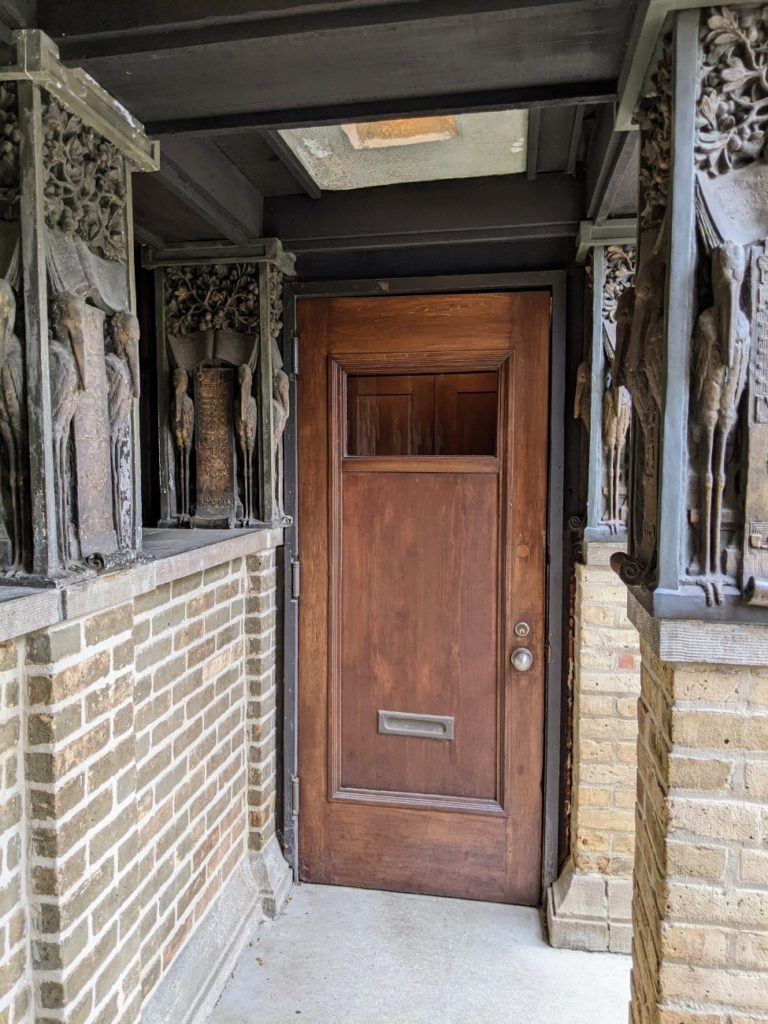
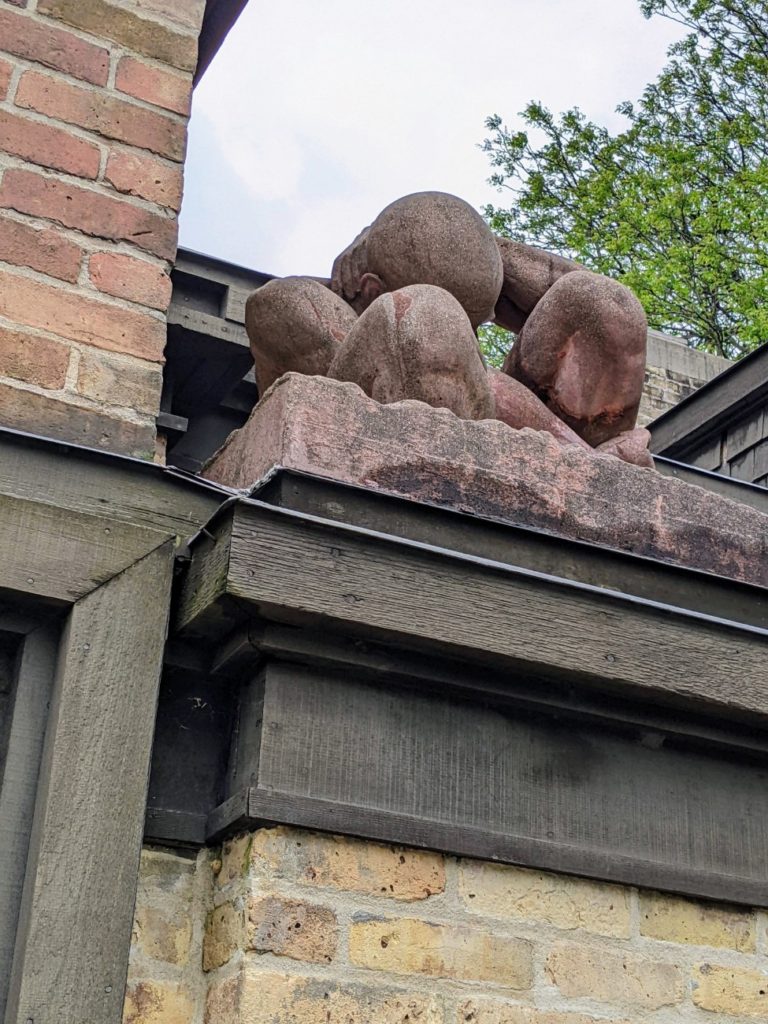
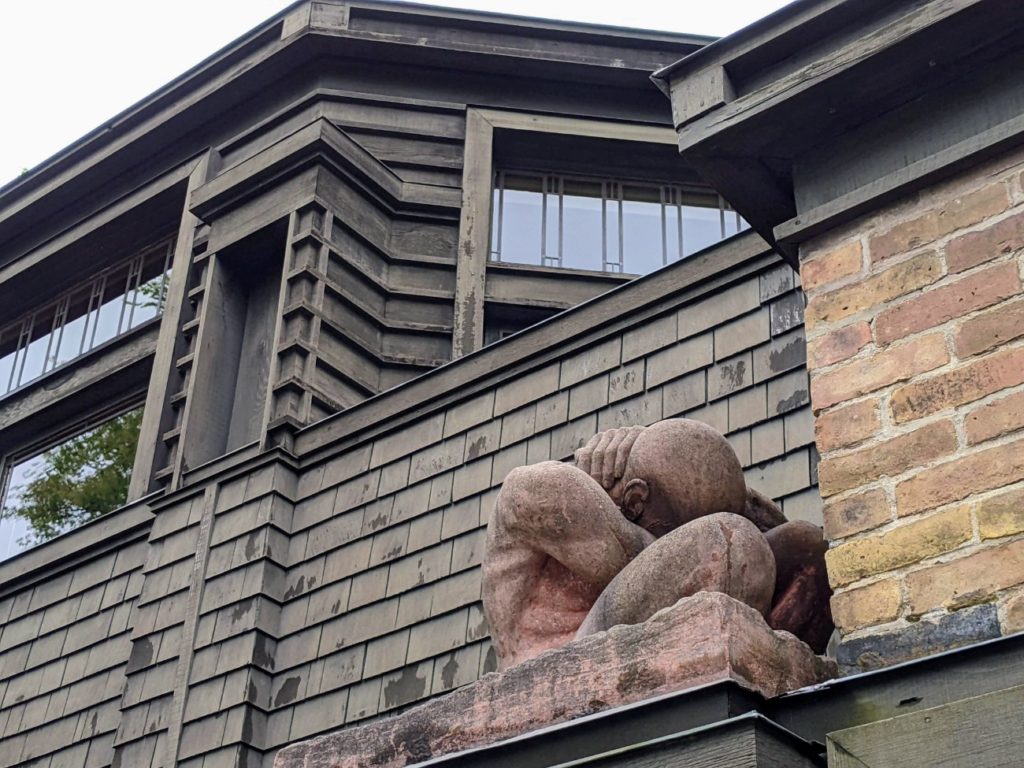
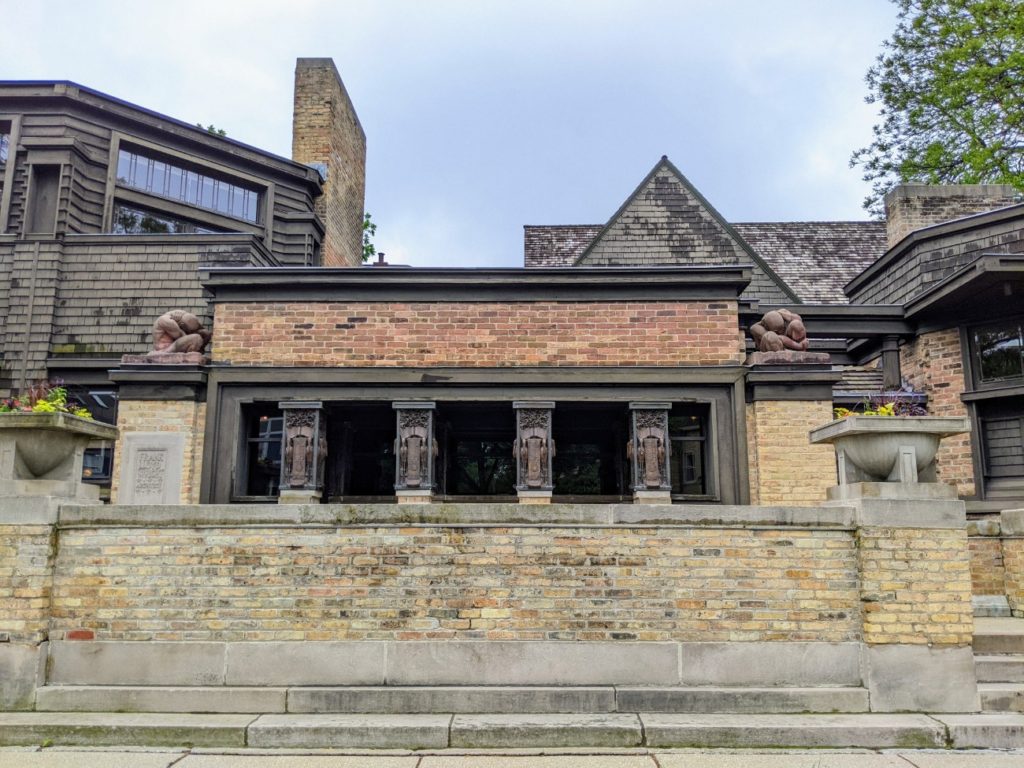
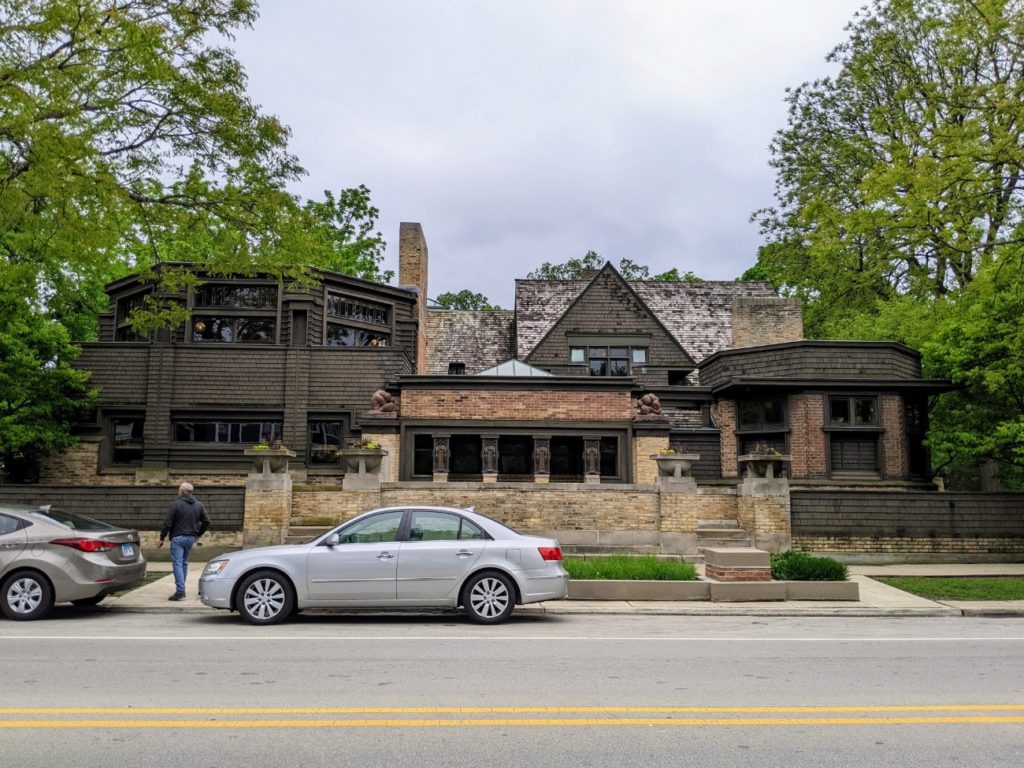
Gift Shop
As fun as it would be to enter from the studio side, you begin and end all tours from the gift shop, through a courtyard to the side. It’s a large shop with lots of options for Frank Lloyd Wright-covered everything. Books, bookmarks, home goods, umbrellas, scarves, puzzles, games, etc., etc., etc. I ended up with a fun laser-cut pop-up card of the Frank Lloyd Wright Home and Studio as a perfect flat-pack souvenir.
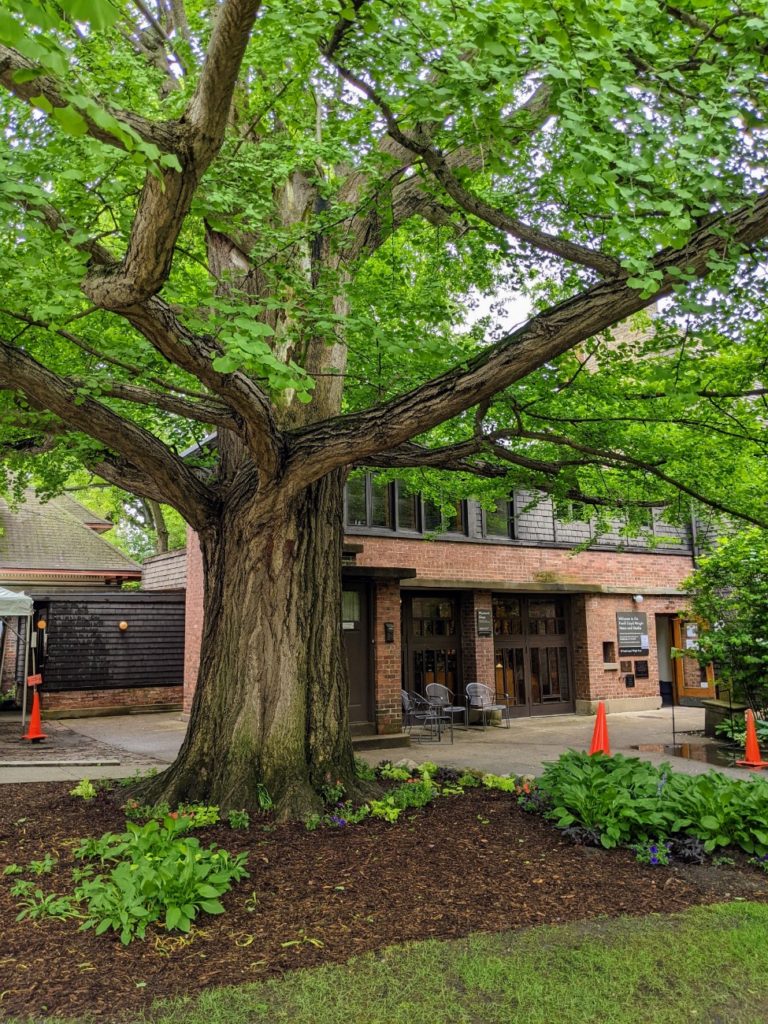
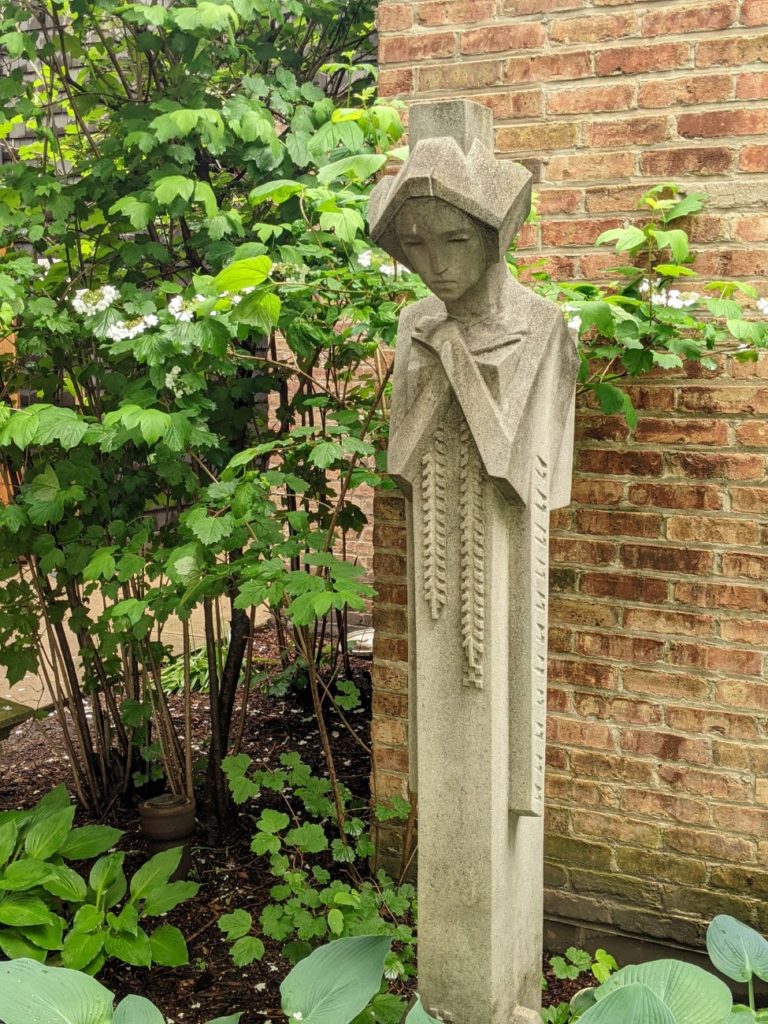
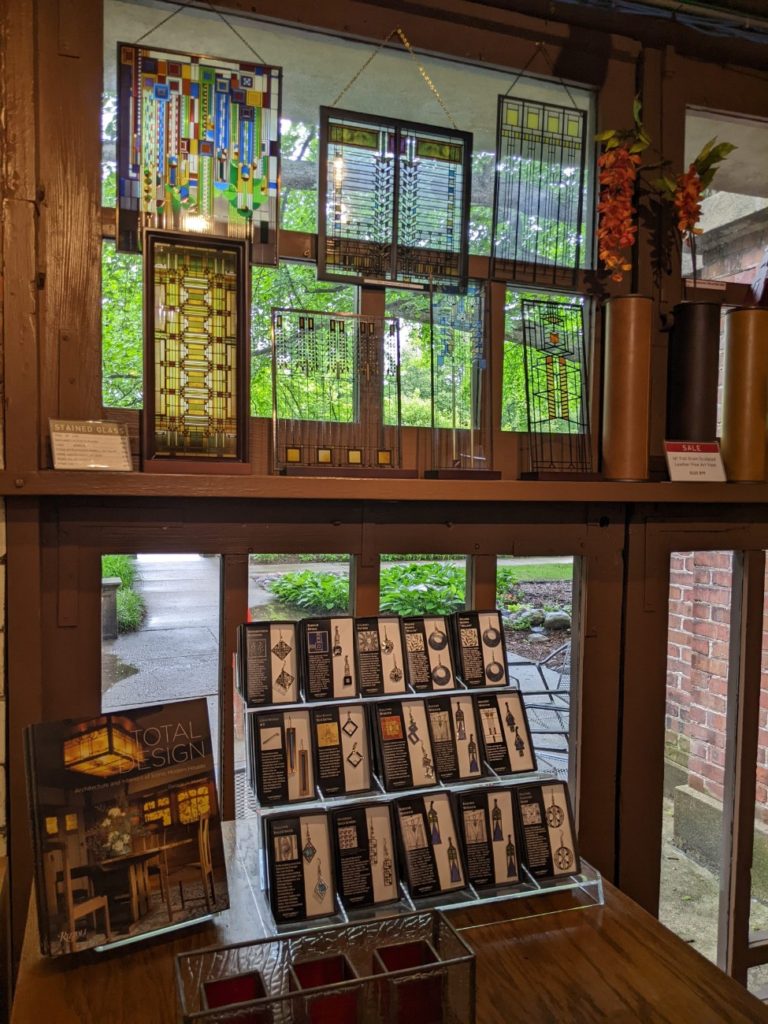
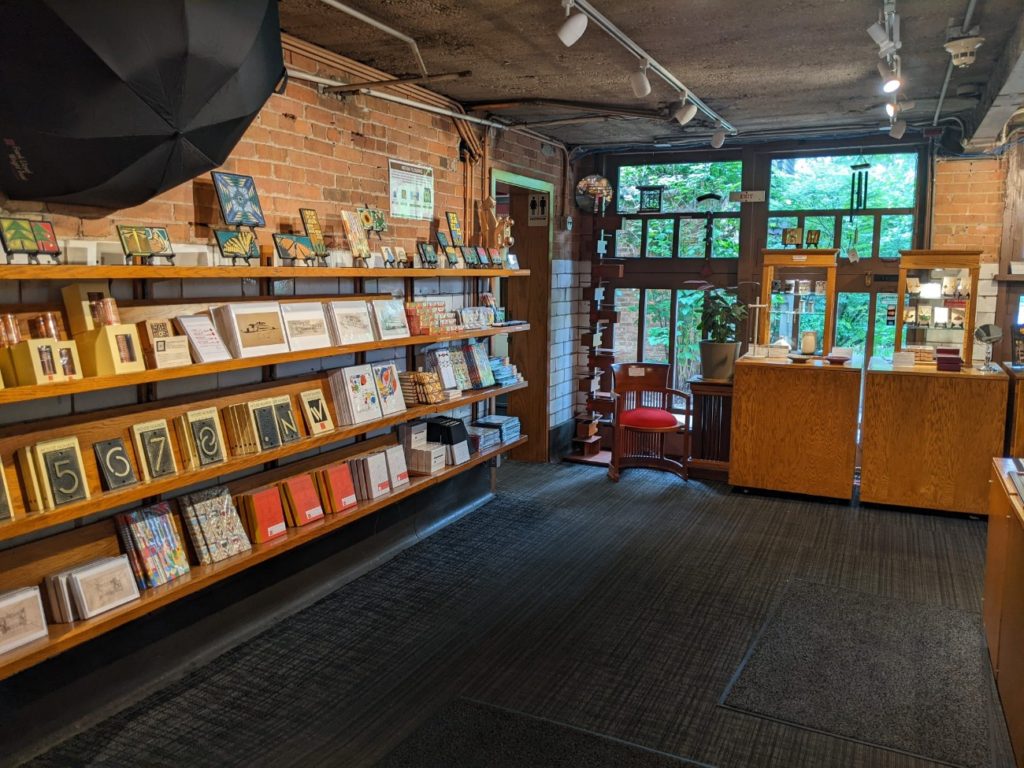
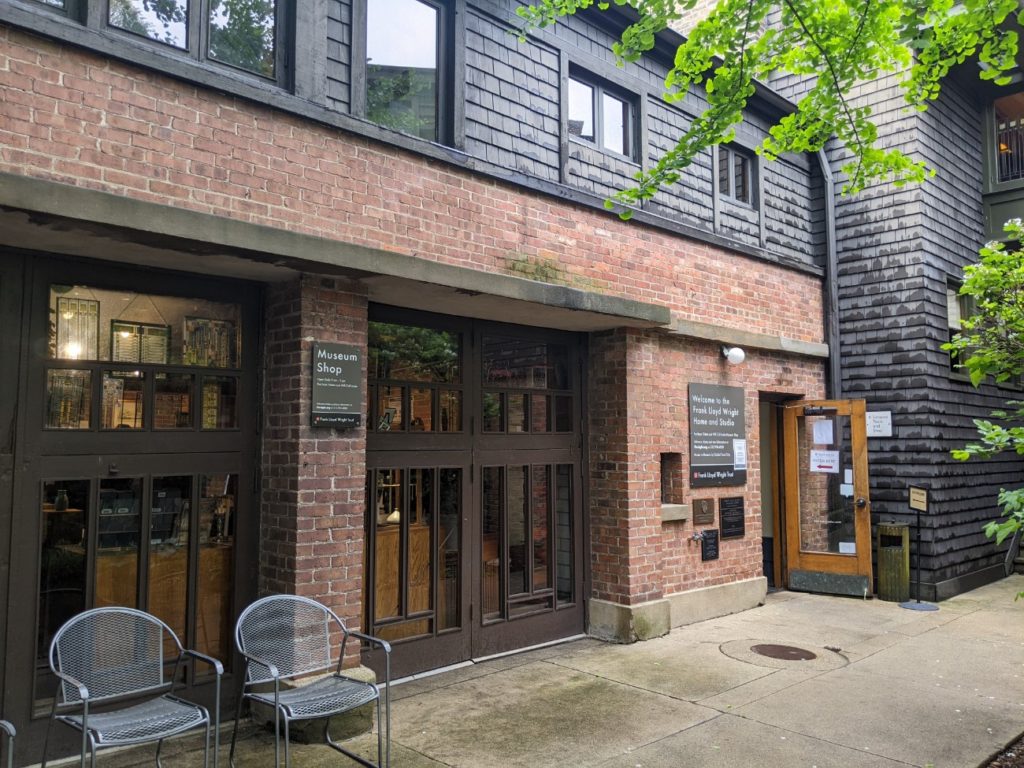
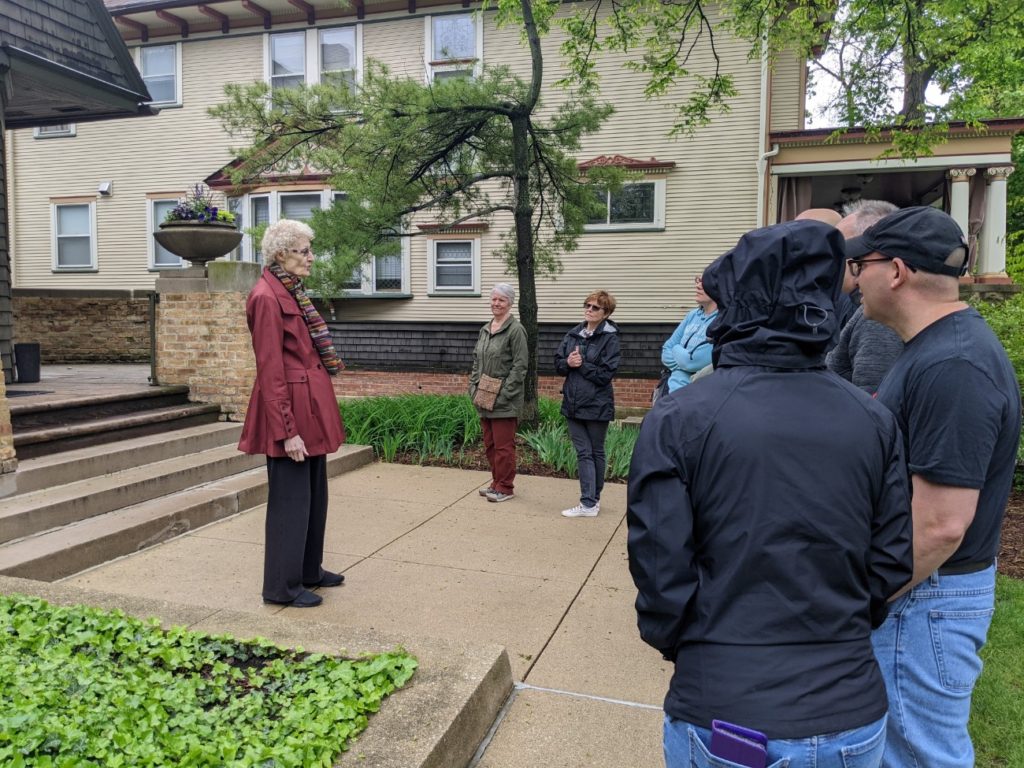
Admission
You buy your tickets for all tours of the Frank Lloyd Wright Home and Studio in the gift shop or online ahead of time. The Home and Studio Guided Interior Tour (the one I took) costs $20, lasts for an hour, and a new tour starts every 20 minutes. There are several Frank Lloyd Wright-designed homes in the immediate area and you can buy a self-guided audio tour for $15 that lasts about 45 minutes. The price is $30 (a $5 discount) for a combined ticket if you want to do both.
There’s also an exclusive in-depth tour of the home and the neighborhood. On this one, you get an expanded tour of the house and studio, including access to the studio balcony, and a fully guided tour of the neighborhood. The whole thing takes two and a half hours and costs $65 per person, with a limit of 8 people per group. Tours start at noon on Saturdays and Sundays from May-September.
Annually, there’s a Wright Plus Housewalk that includes entrance to private homes in Oak Park designed by Frank Lloyd Wright and some of his contemporaries. Tickets in 2022 cost $125, or as much as $600 if you want to skip the lines.
Hours & Parking
Tours at the Frank Lloyd Wright Home and Studio are offered between 10 am-4 pm every day except for Thanksgiving Day, Christmas Eve, Christmas Day, and New Year’s Day. The gift shop is open daily from 9:30 am-5 pm with the same exceptions.
The gift shop and some portions of the studio can be accessed by wheelchair, but to tour the whole thing, you’ll need to be able to navigate stairs, particularly on the home side. If you have accessibility issues, call 312.994.4000 or email info@flwright.org to see what your options are.
Parking is on the street along Chicago Avenue, and it’s not even metered. The site is also in easy walking distance from Lake Street, which has a lot of restaurants and shops. But otherwise, The Frank Lloyd Wright House and Studio is still in a residential neighborhood, just like it was 125 years ago.
Unity Temple
But wait, there’s more! I didn’t tour any of the other Frank Lloyd Wright spots, but I drove by the ones in the Chicago area just to look.
In the same Oak Park neighborhood as his home and studio, you can tour Unity Temple on Lake Street. This is a Frank Lloyd Wright-designed church still used by an active Unitarian Universalist congregation.
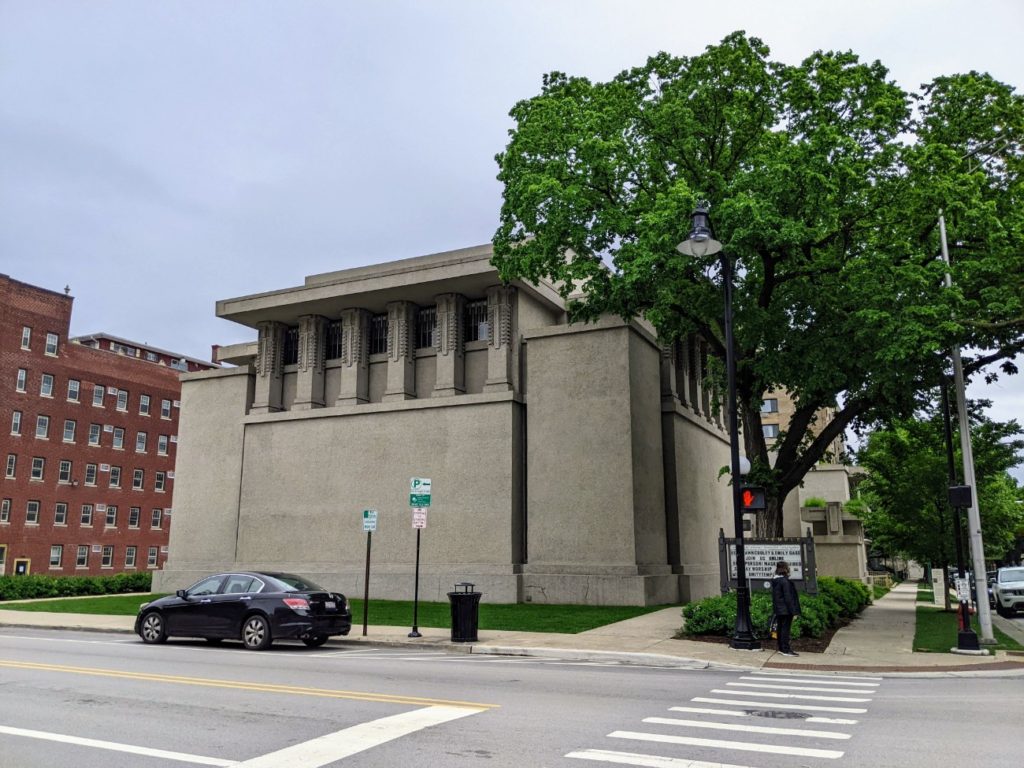
You could probably show up for a Sunday service at 10 am, or try to catch a music concert there. But to get a guided tour, they are given twice a day, Monday-Friday, at 10 am and noon. Each lasts 45 minutes and costs $20. Otherwise, you can take a self-guided audio tour anytime Monday-Saturday, for $15. The building is open from 9 am-3 pm during the week and 9 am-noon on Saturdays. A more in-depth guided tour is offered on Saturdays at 9 am, lasts 90 minutes, and costs $40.
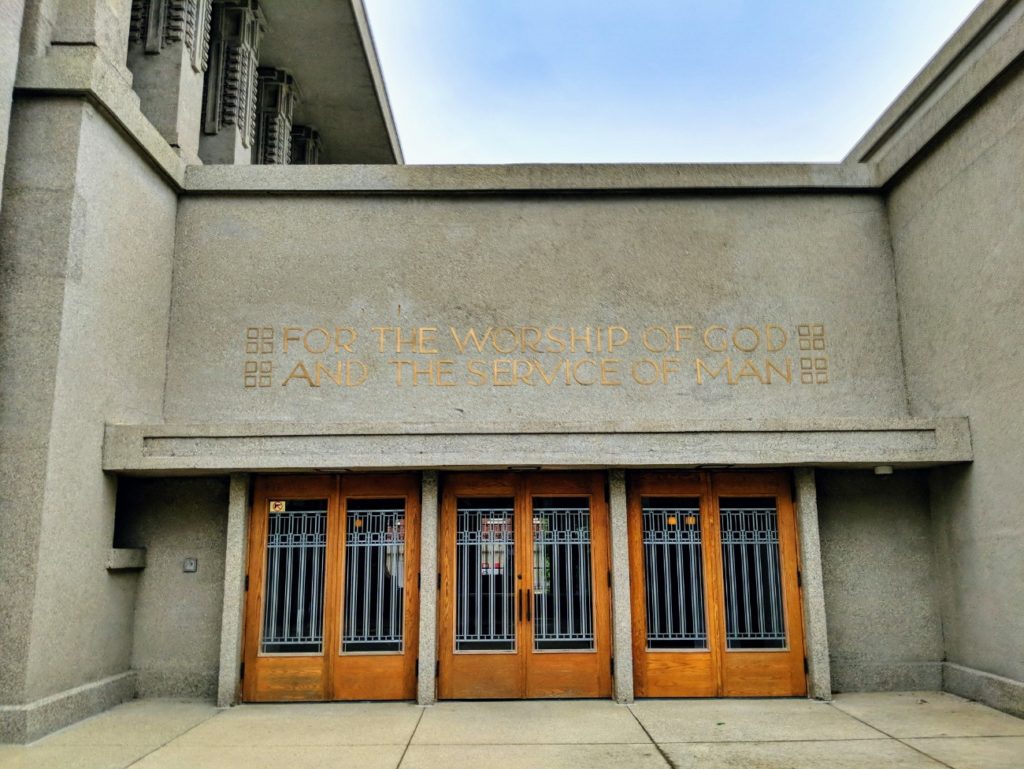
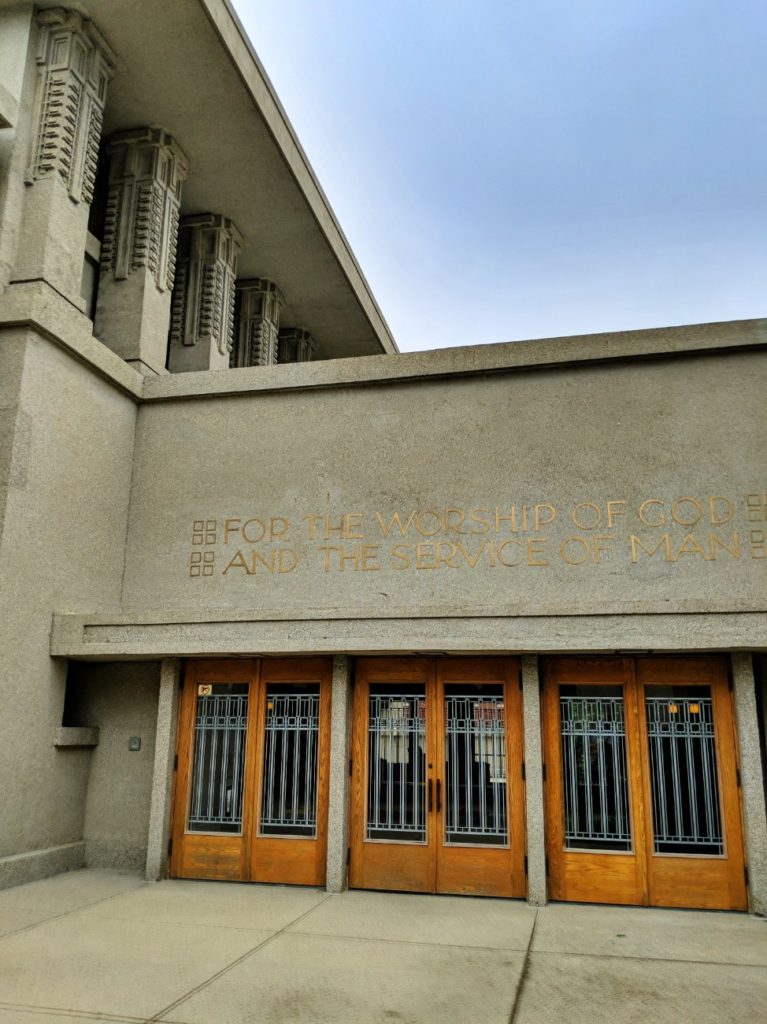
Rookery Lobby
Right in downtown Chicago is the Rookery building, built in 1888. The lobby was redesigned by Frank Lloyd Wright in 1905. Part of its ingenious design is the inclusion of a “light court”, a central light-filled lobby that affords daylight into the interior offices. When Frank Lloyd Wright updated the lobby, he opened it up to even more light with filigree ironwork and floating stairs. It’s been described as like being inside a clock.
There’s no fee to walk into the lobby, though make sure to enter from the Adams street side and check in with the front desk. Just tell them you’re there to look at the lobby. The Light Court is open to the public Monday-Friday from 7 am-6 pm and Saturday from 8 am-2 pm, and not open on Sundays. All parking is at street meters.
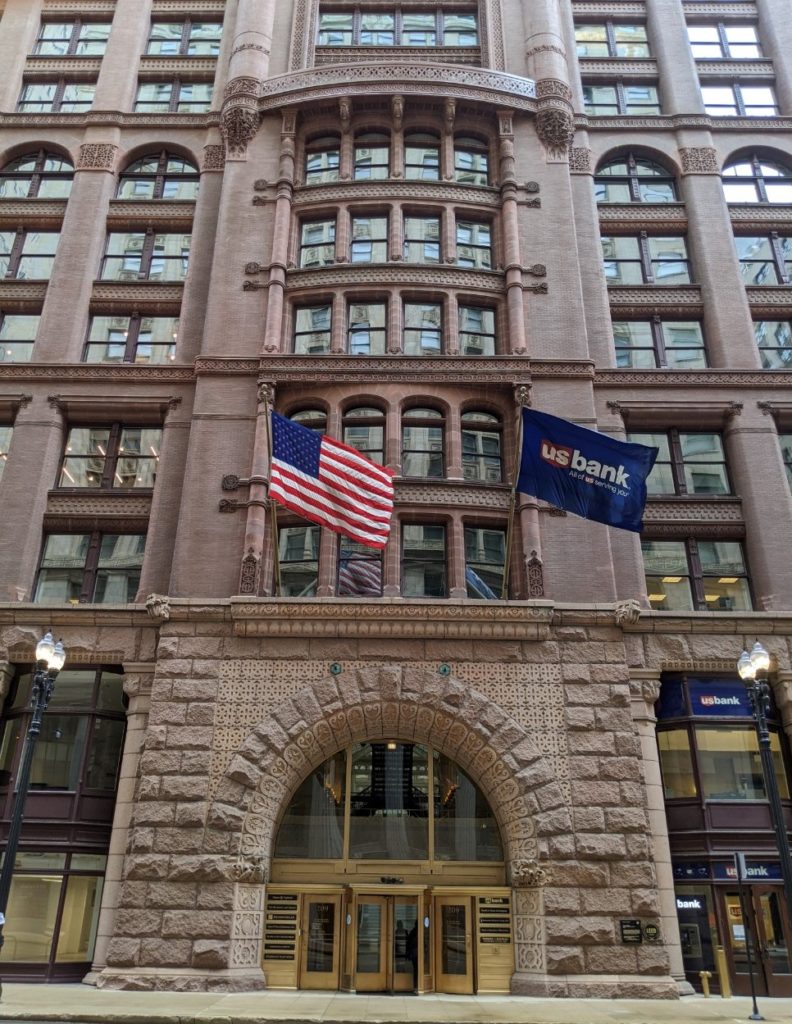
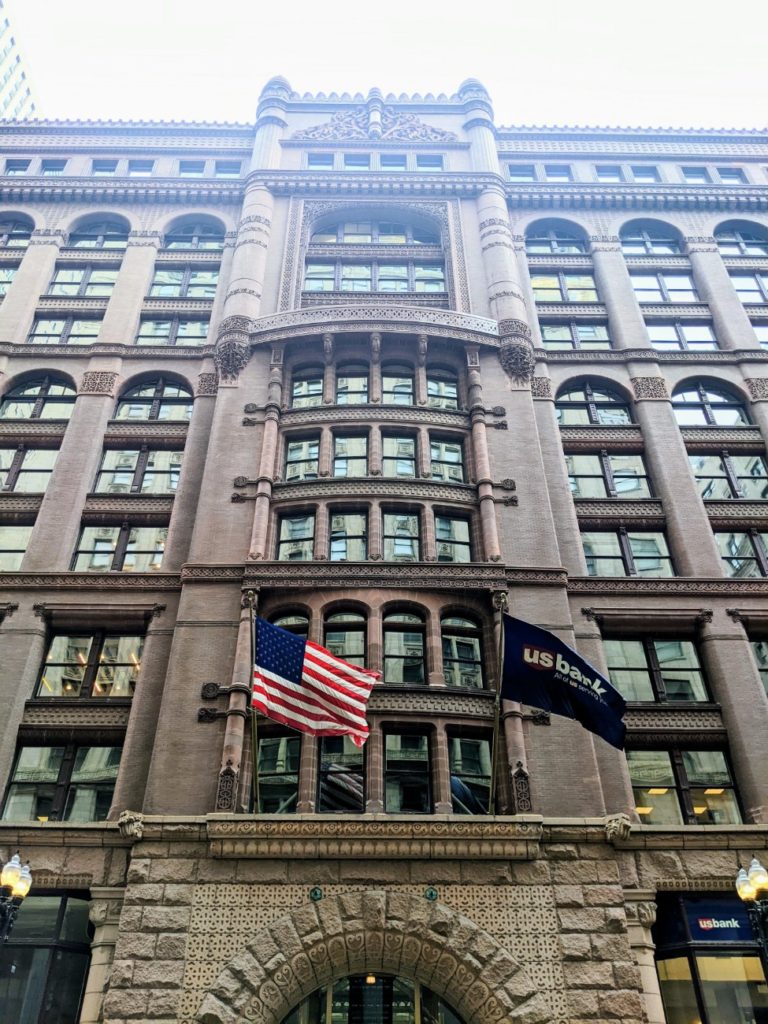
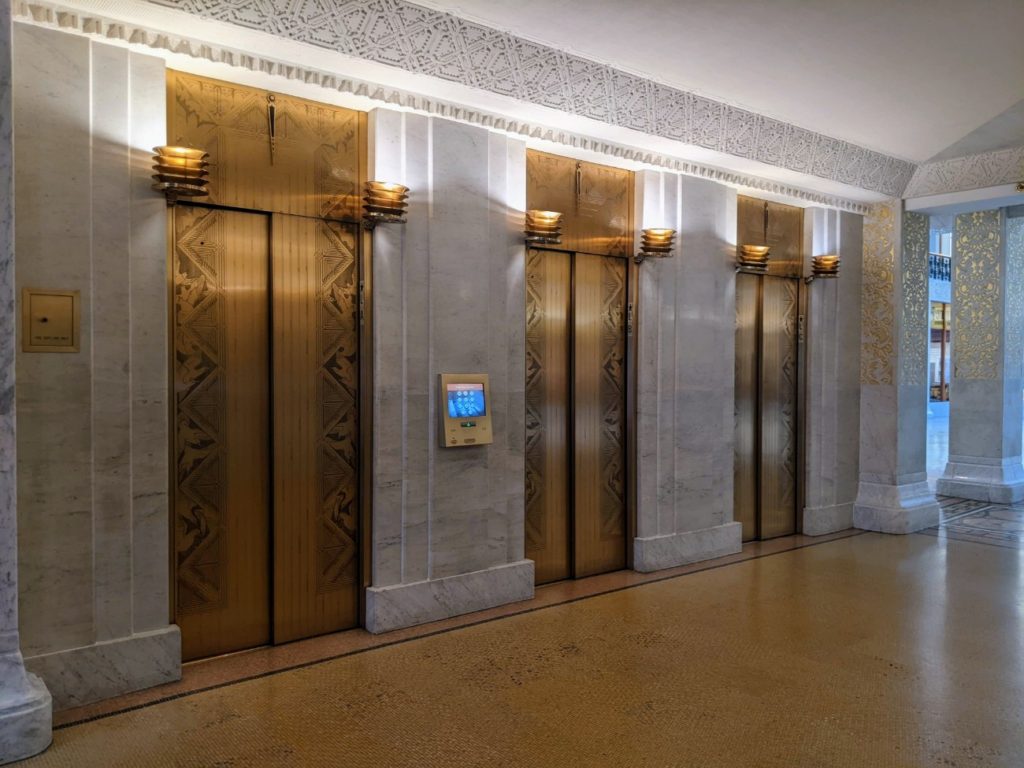
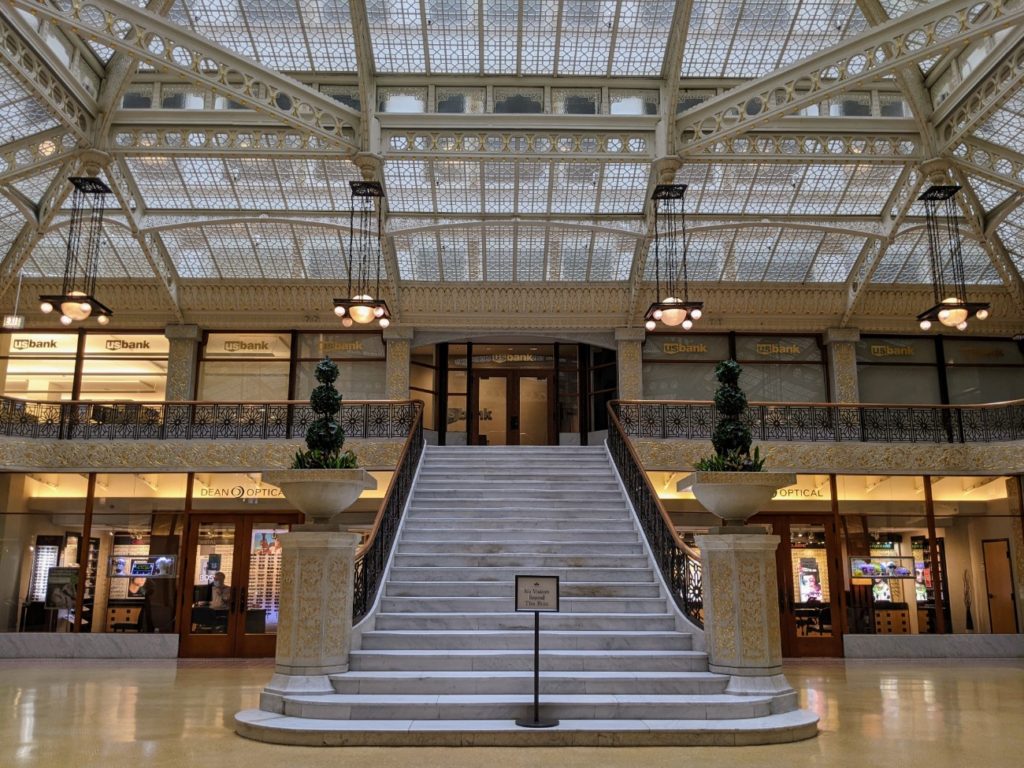
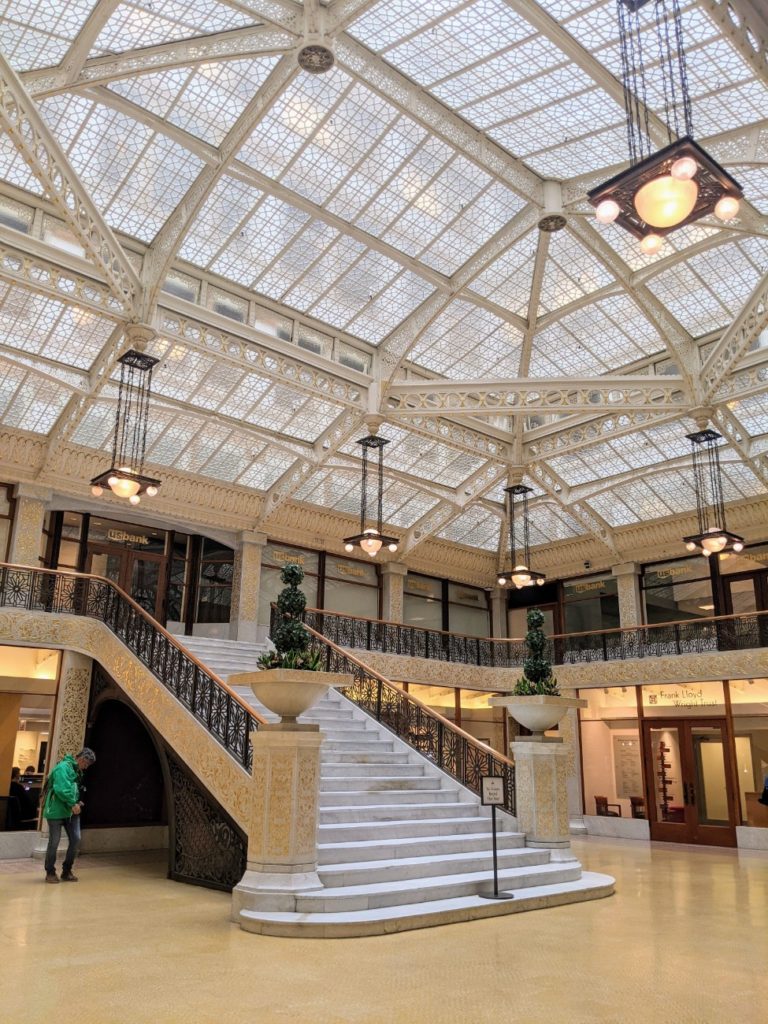
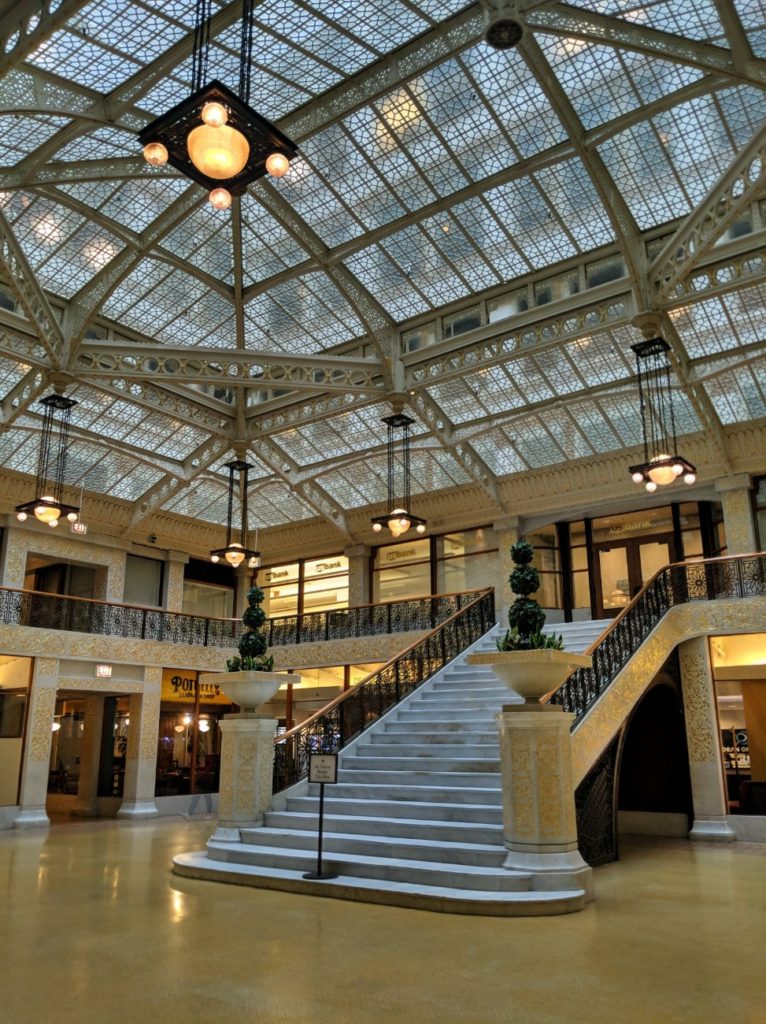
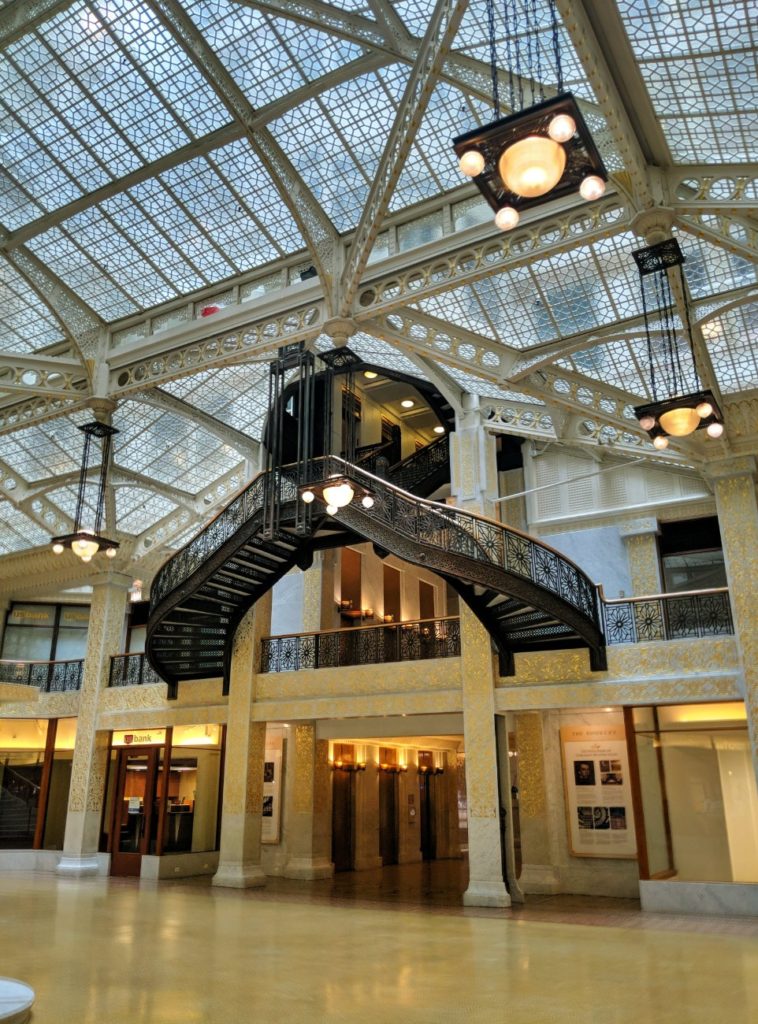
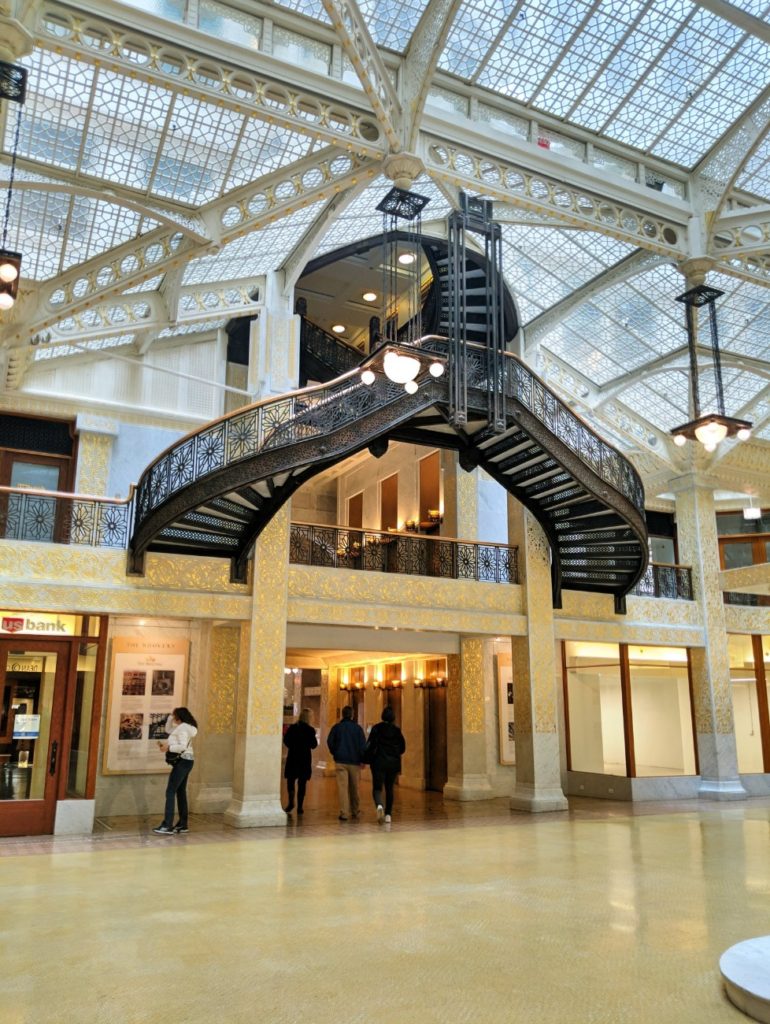
Emil Bach House
The Emil Bach House is the only Frank Lloyd Wright house that you can rent for overnight stays and events! (At least in the Chicago area.) The rate seems to be around $500/night for up to 6 people, and it’s regularly booked pretty far in advance.
Besides staying overnight, the only way to tour the Emil Bach House is via the exclusive Wright Along the Lake tour. For $195, you can tour the Rookery and go upstairs, tour the Emil Bach House, and have lunch at the Robie House (see below) plus, guided narration of the city of Chicago on the bus in between. The tour is only available on Wednesdays and lasts from 9 am-2 pm.
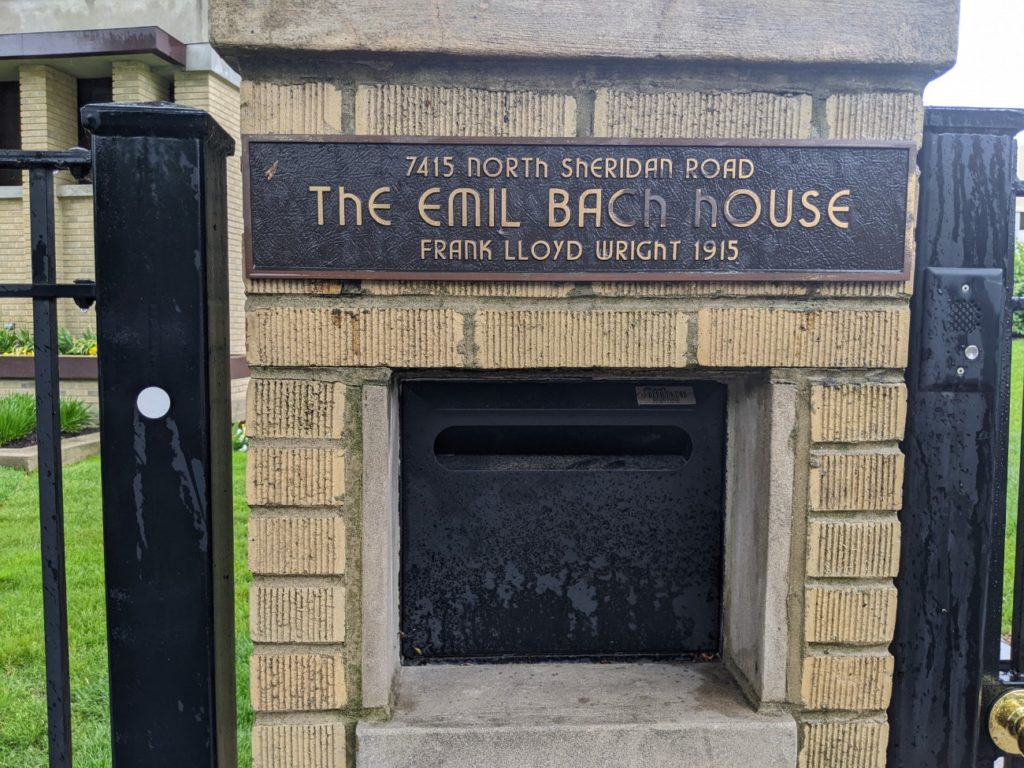
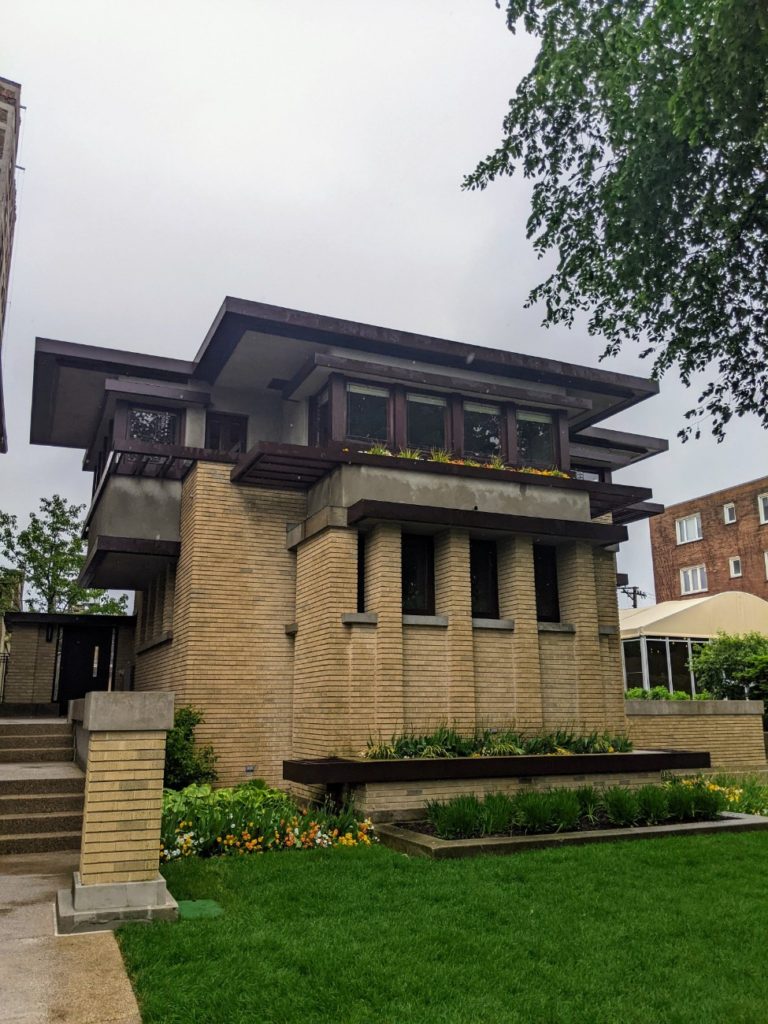
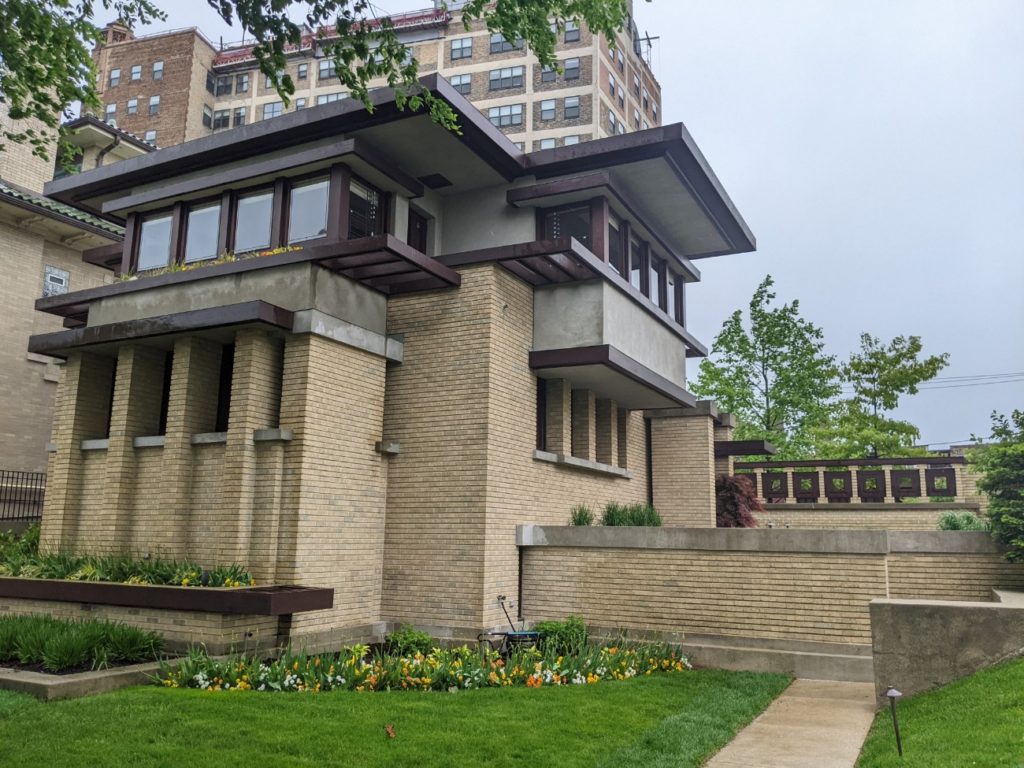
Charnley-Persky House
Now, the Charnley-Persky House isn’t a Frank Lloyd Wright design, but he was a junior draftsman on the project under Louis Sullivan. And it’s considered a pivotal work into modernism, it’s on the official Frank Lloyd Wright trail, and you can tour it.
The tour situation at Charnley-Persky is a little unusual – or at least, it’s a little hard to explain. Here goes: There are tours on Wednesdays year-round for FREE at noon, though you have to make a reservation and it’s limited to 10 people. Friday tours are also at noon, limited to 10 people, but cost $10 ($8 for seniors 65+ and students.) And these only last “through August.” Saturdays offer two options, a 10 am tour is offered April-October, and a noon tour is offered year-round. These also cost $10 and are capped at 10. All tours last 45 minutes. Parking is on the street or in paid lots.
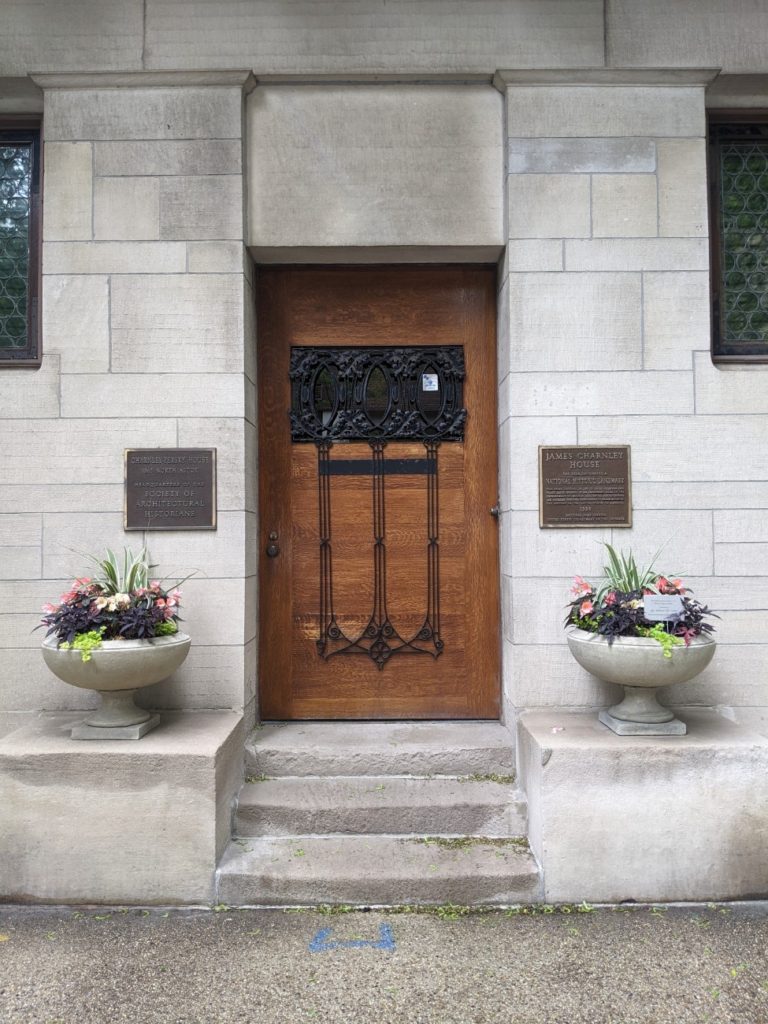
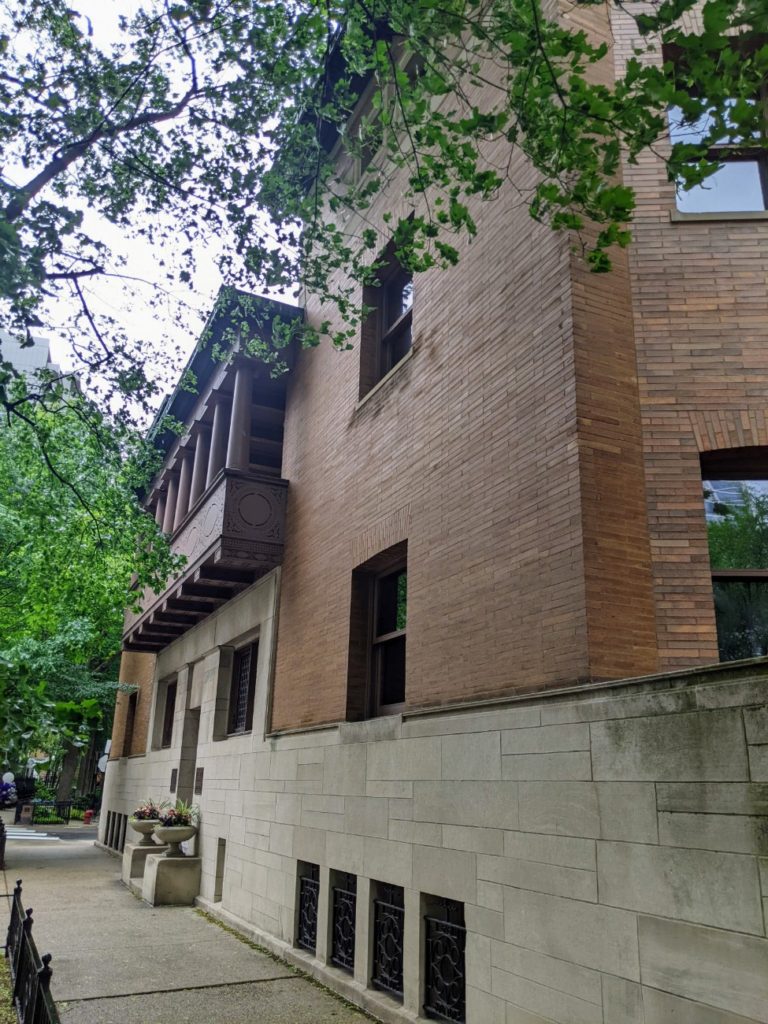
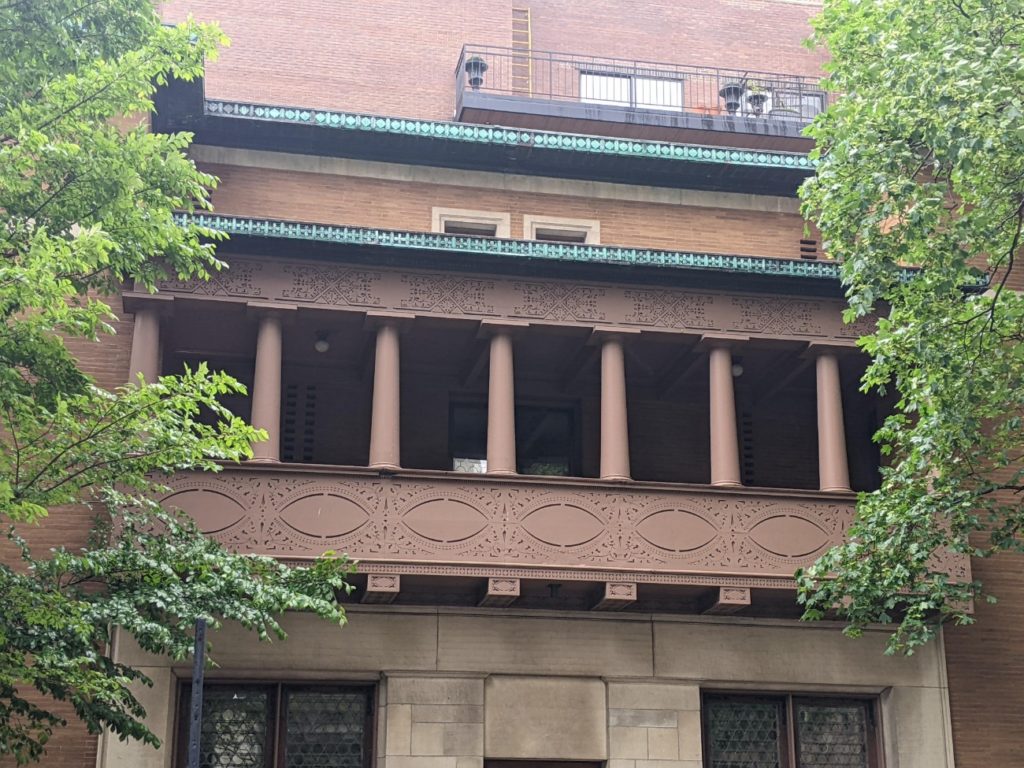
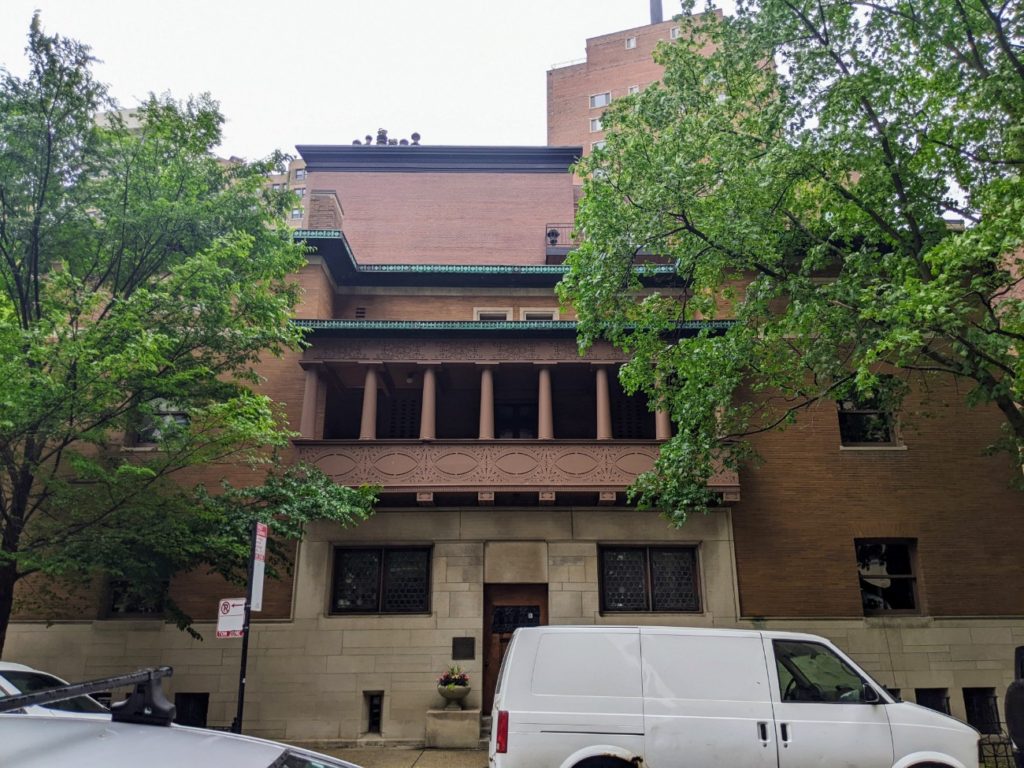
Robie House
Located on the campus of the University of Chicago, the Robie House is considered one of the last and finest examples of Frank Lloyd Wright’s prairie style, and one of the last he designed in his Oak Park studio. It seems large for a Frank Lloyd Wright house, more on the scale of a mansion – at least in 1910 terms. (I would have loved to tour it but I was too late.)
If you want to take a tour, the Robie House is open Thursday-Monday, 9:30 am-4 pm, with tours from 10 am-2:30 pm. Tours of the house take 45 minutes and cost $20, or pay $30 to add an additional 45-minute outdoor tour. A more extensive tour is offered Saturdays and Sundays at 3 pm. It costs $75 and lasts 90 minutes. Parking is on the street and very limited.
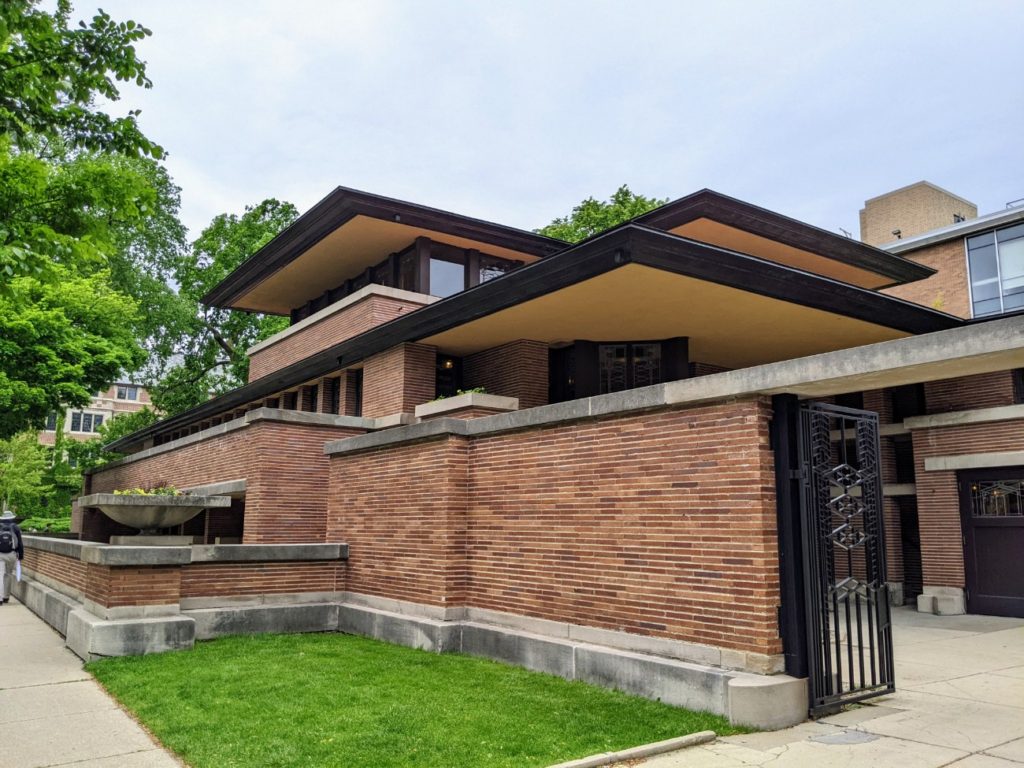
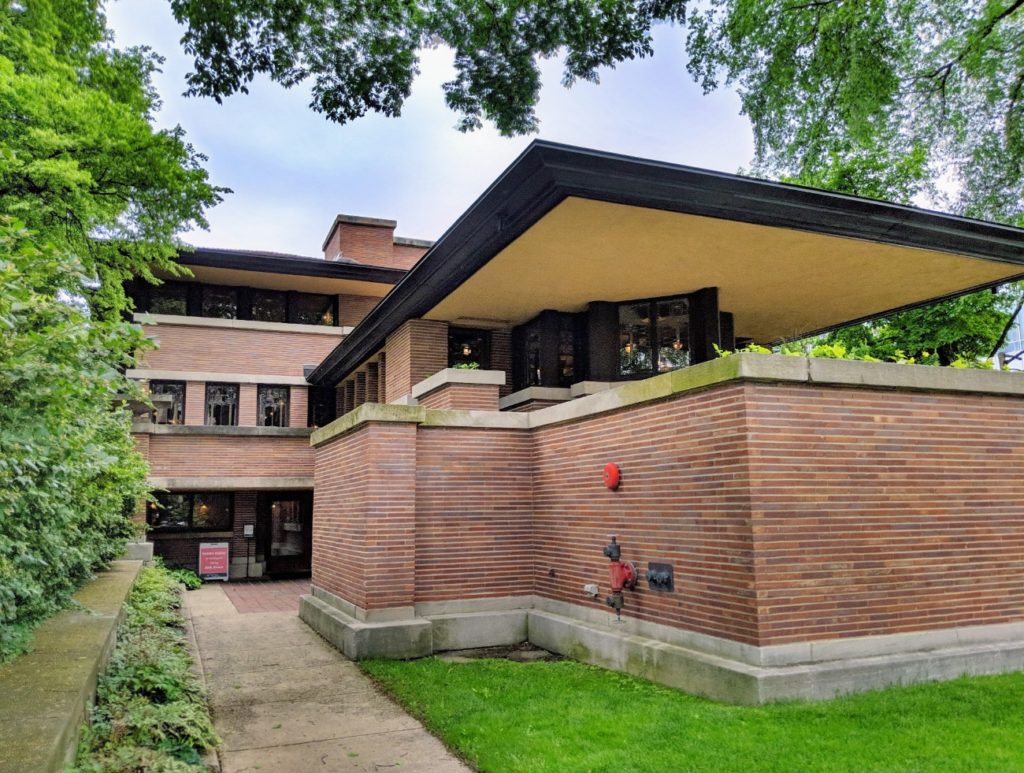
I haven’t gone much into the actual design of Frank Lloyd Wright’s designs. All the architectural elements of prairie style (a term he didn’t use himself) and the names of the patterns found in glass and wood. And I haven’t mentioned that he designed the lighting, furniture, and textiles for his homes as well, though you may have figured that bit out for yourself. Instead, this is a high-level attraction-based review of what it’s like, and what it takes, to tour his Chicago-area works.
That’s one of my favorite things about travel – I don’t have to know about a subject before I encounter it. I can show up and learn. And the more I learn, the more it deepens my enjoyment of the subject when I encounter it next. I will definitely be hunting down Frank Lloyd Wright locations in the future!
Sara Beth, Mary and I love Frank Lloyd Wright homes! We’ve only been to two of them, in western PA, but after reading your well-written guide and seeing the great photos you took, we have a compelling reason to visit Chicago some day! What a splendid job of recording your experiences. Outstanding travel blog!
Thank you so much! I really appreciate that.
Wow, that house looked amazing! The creativity is insane!